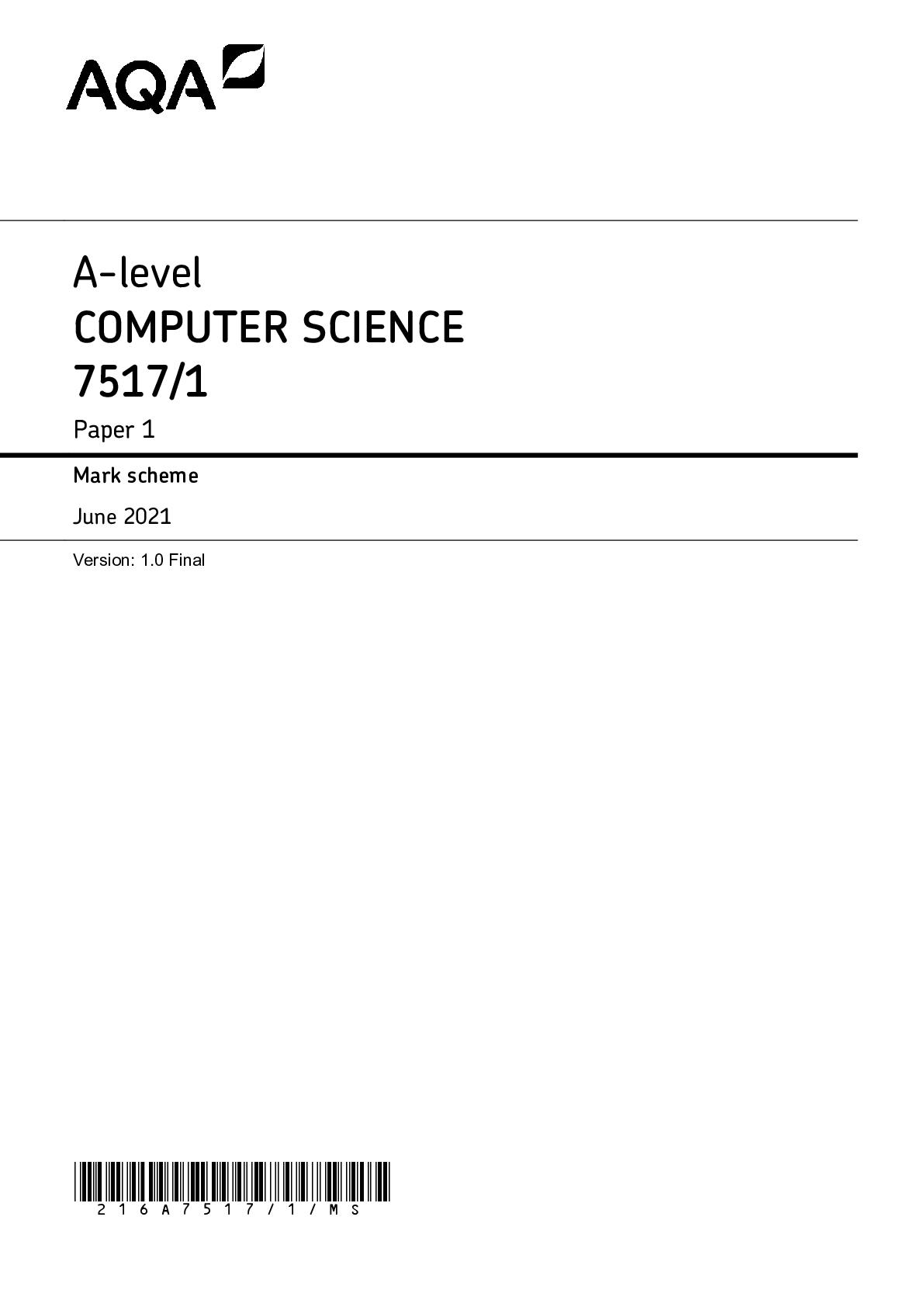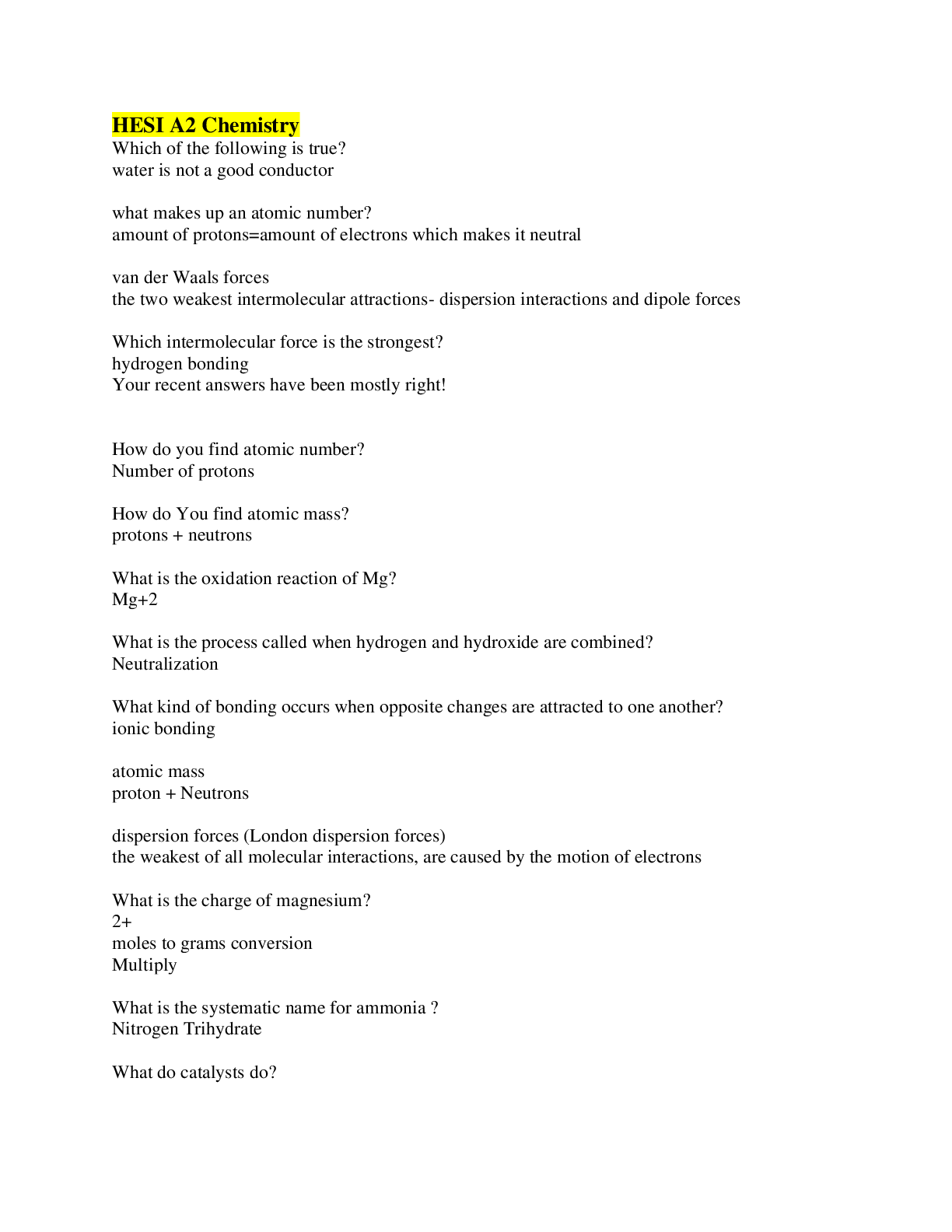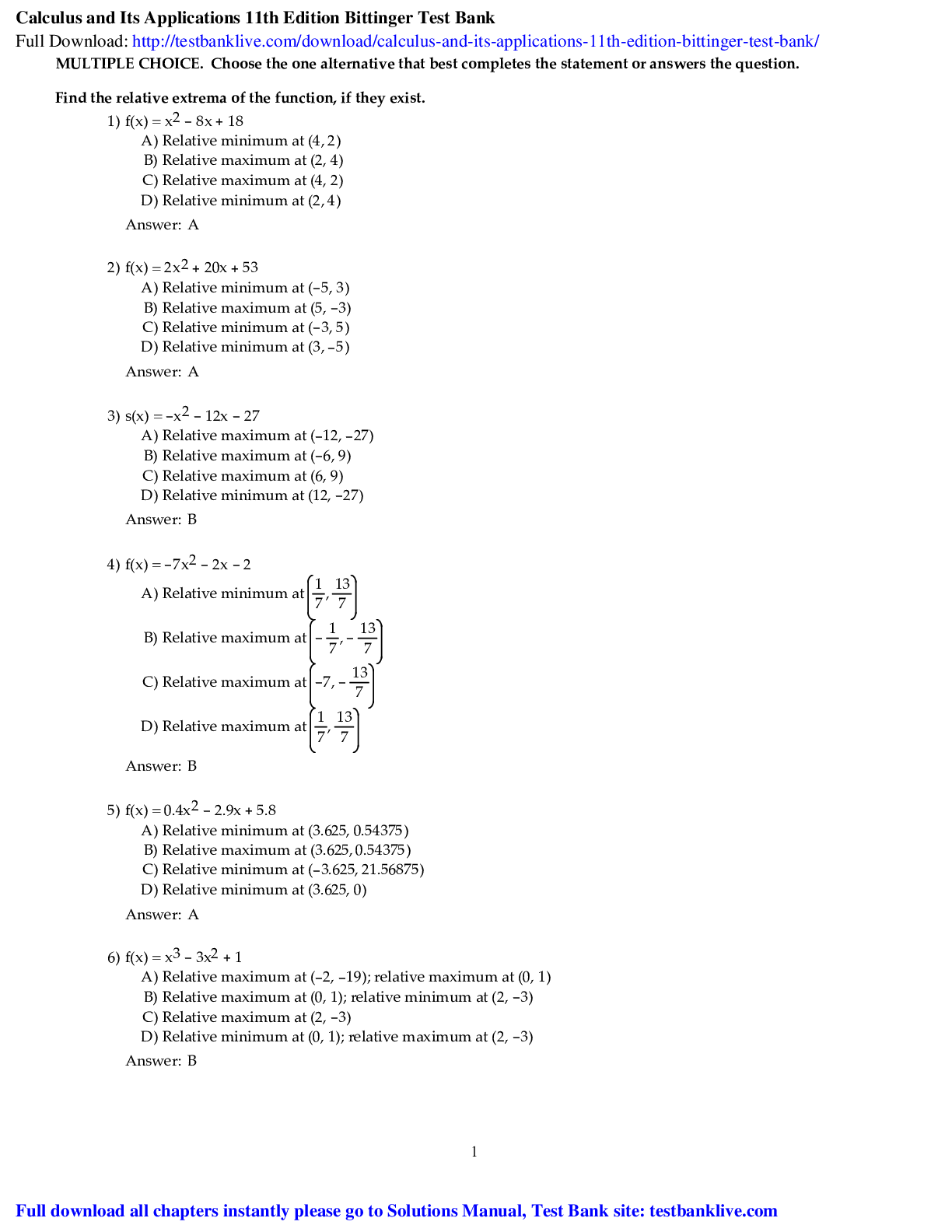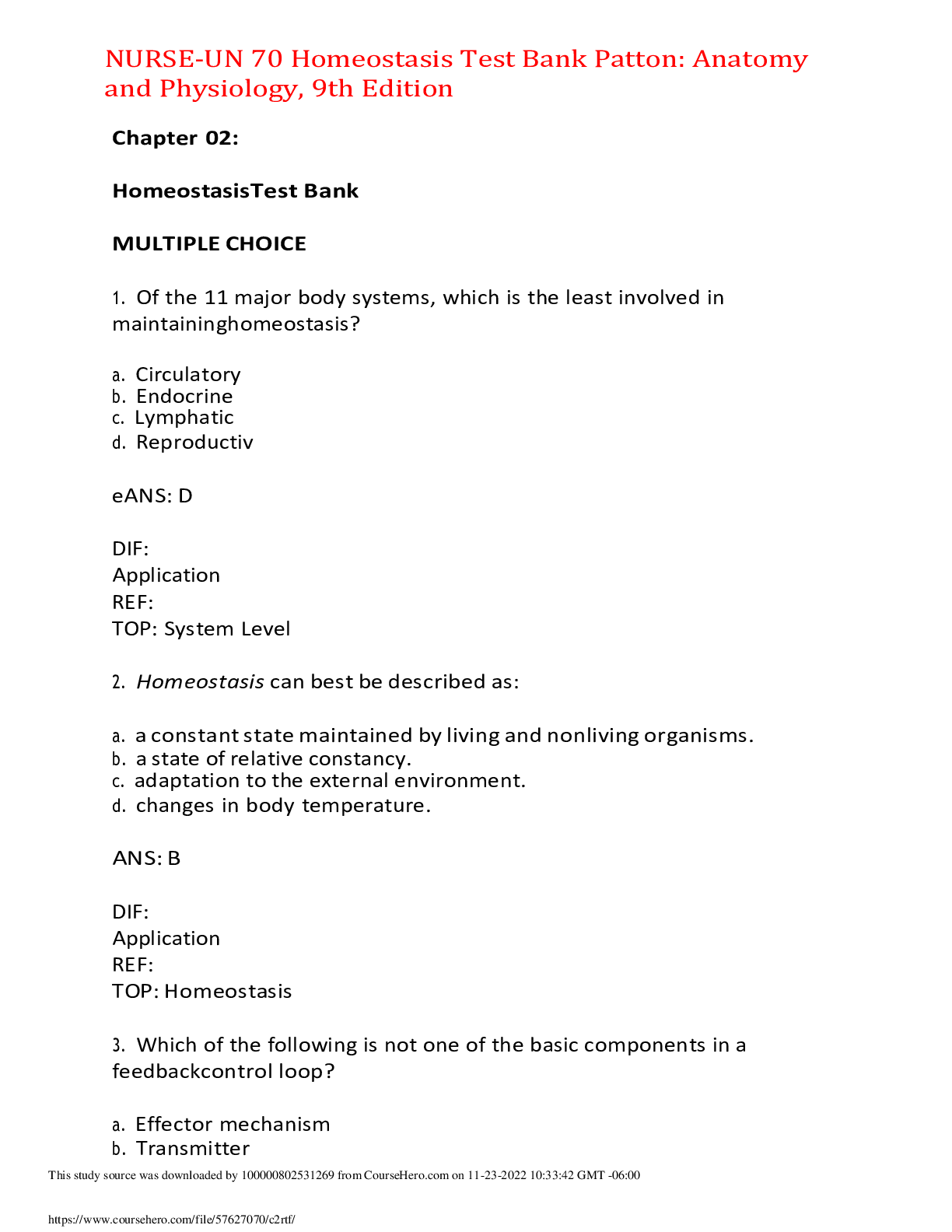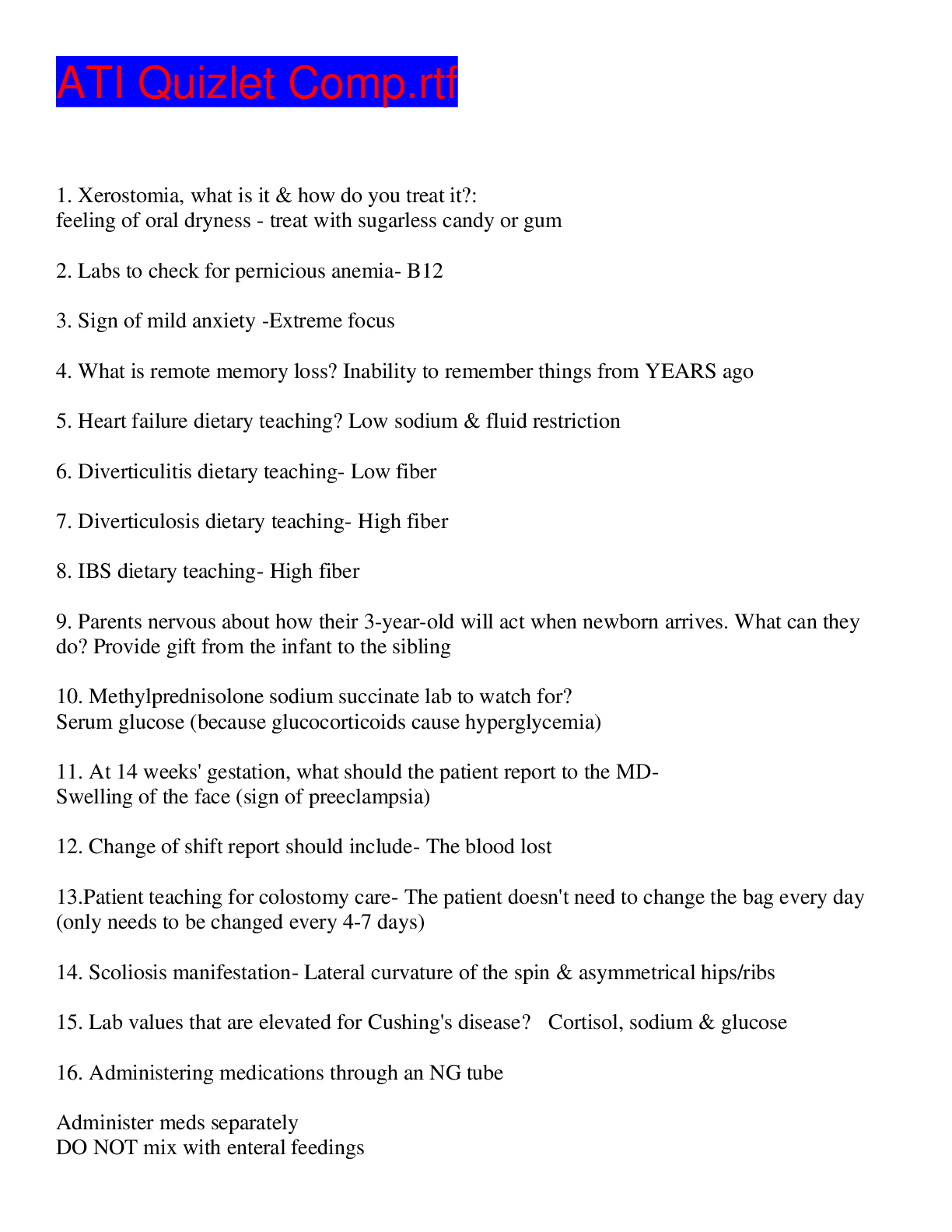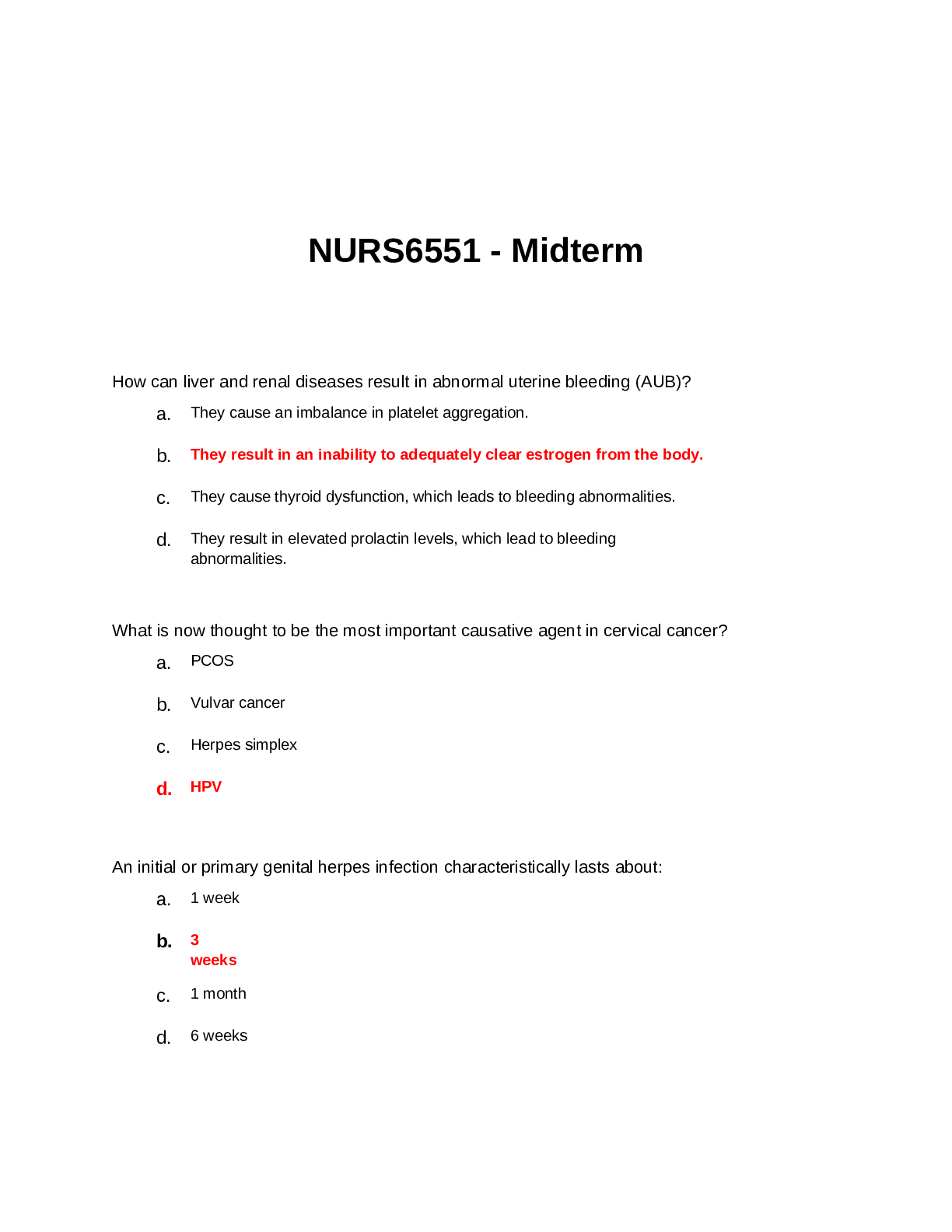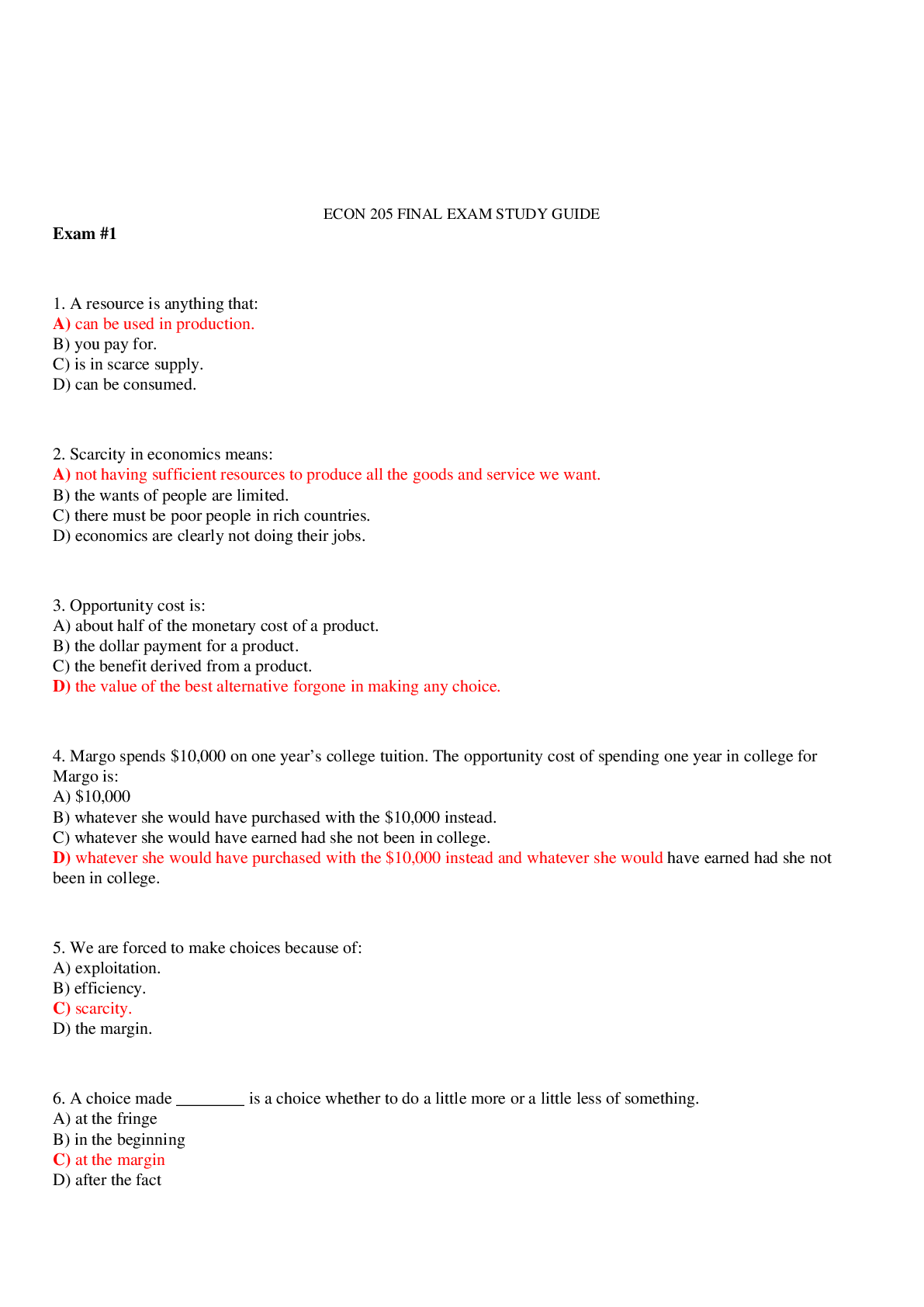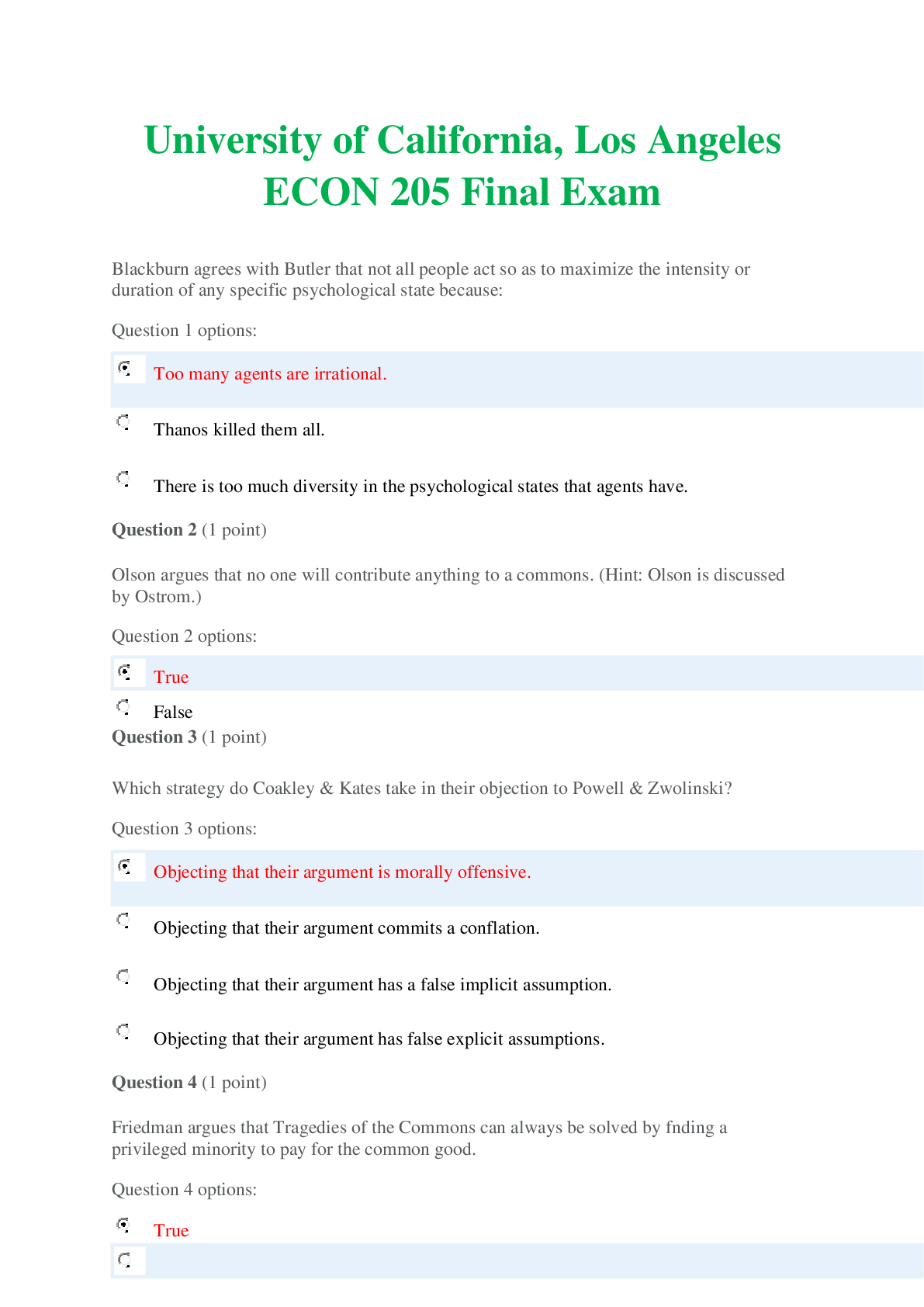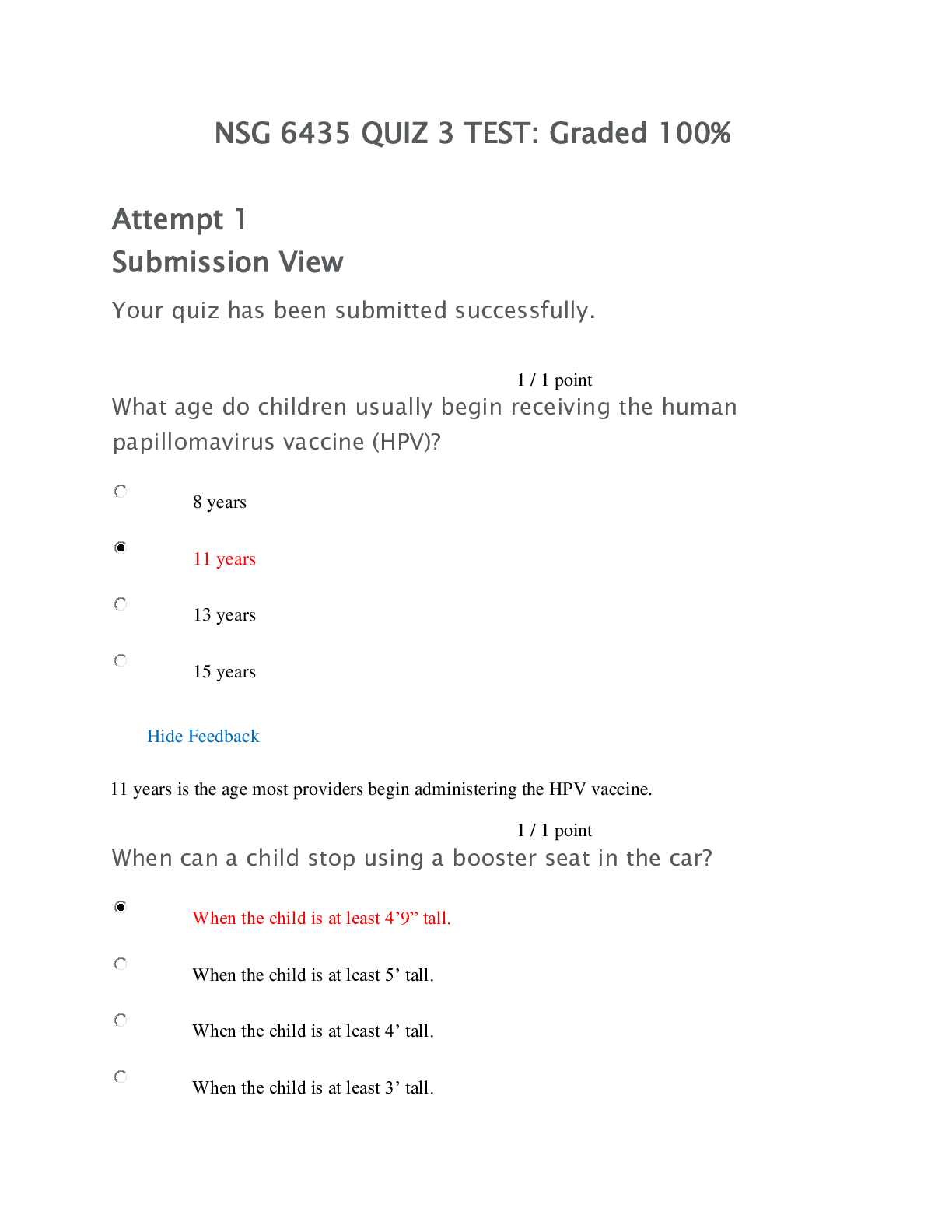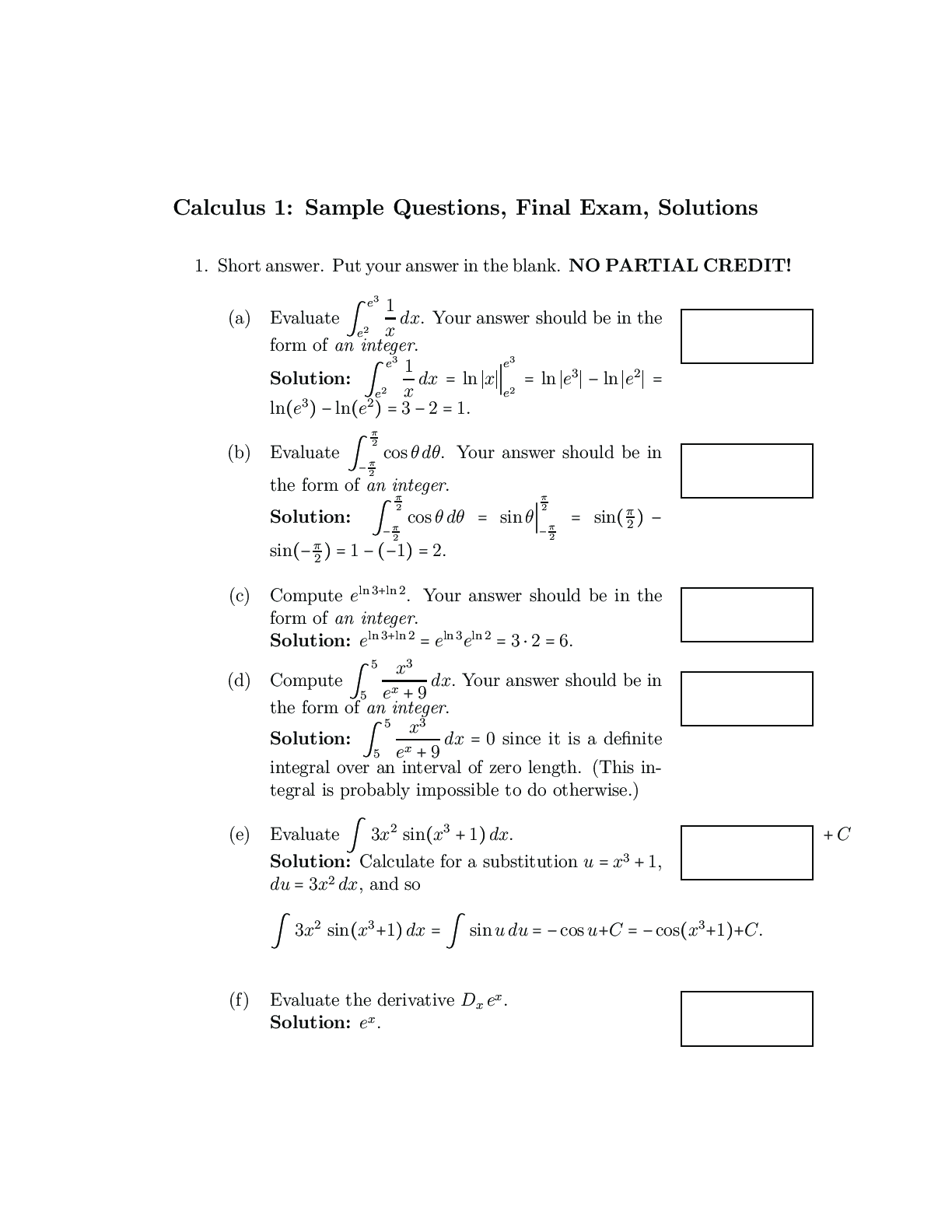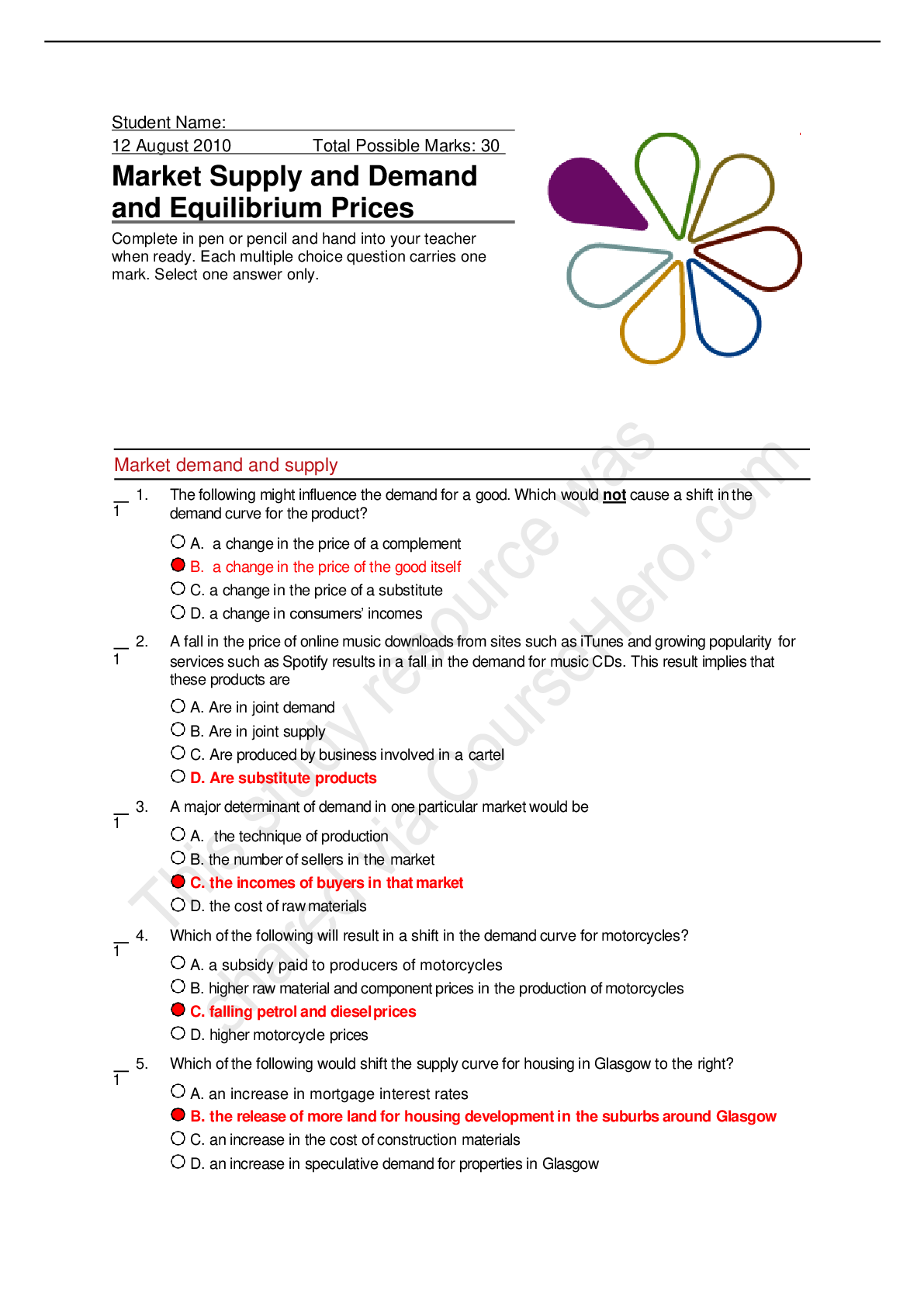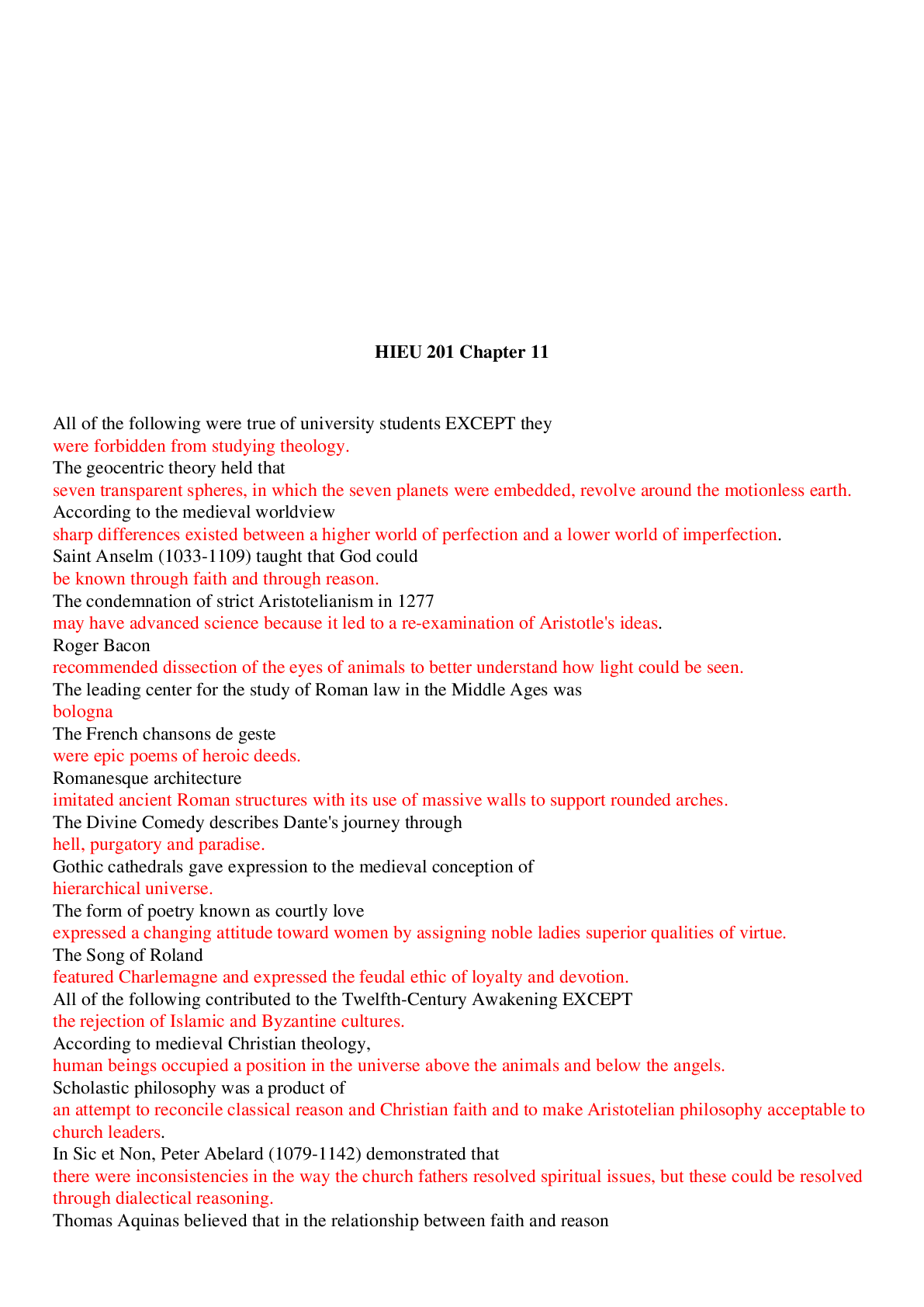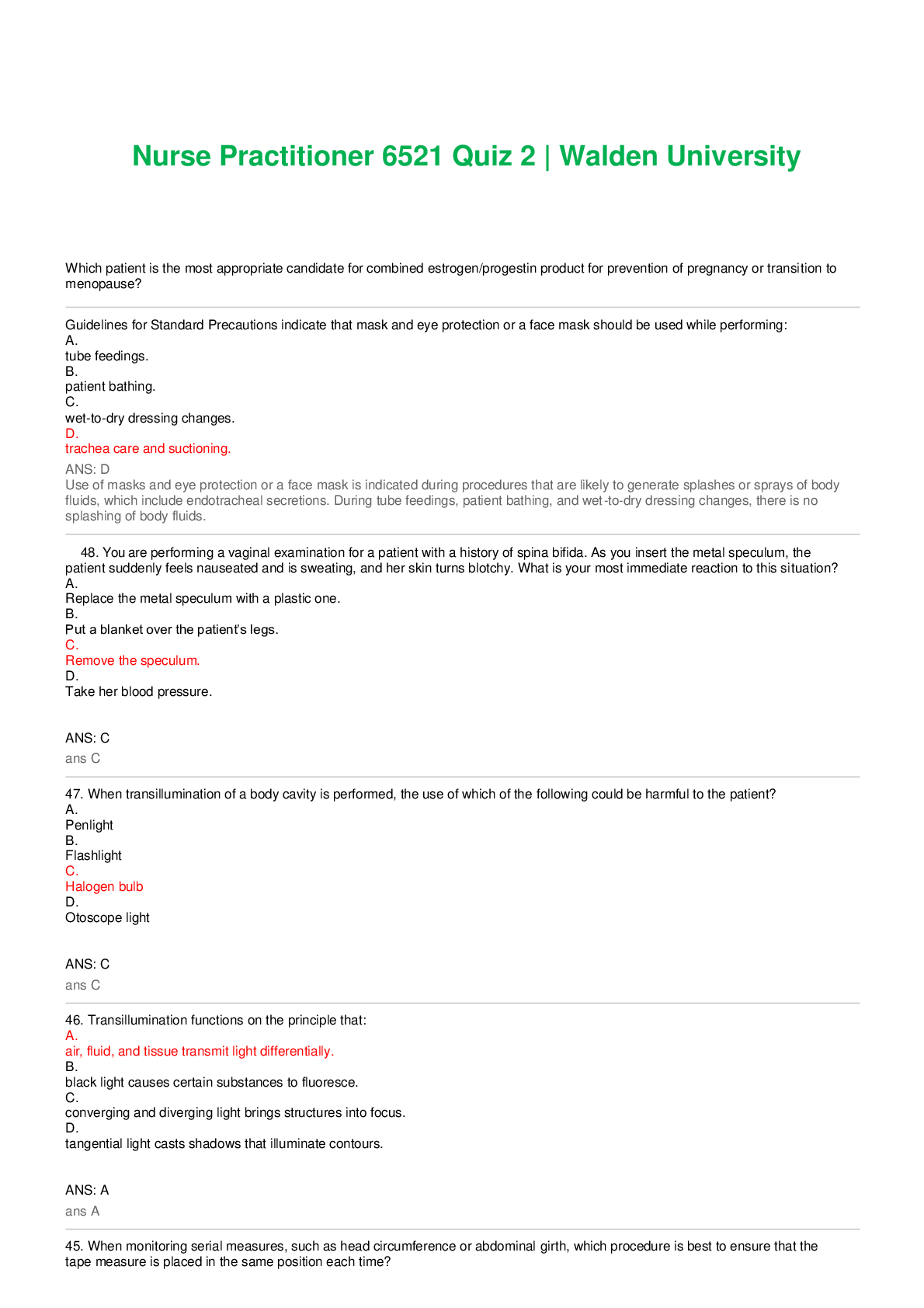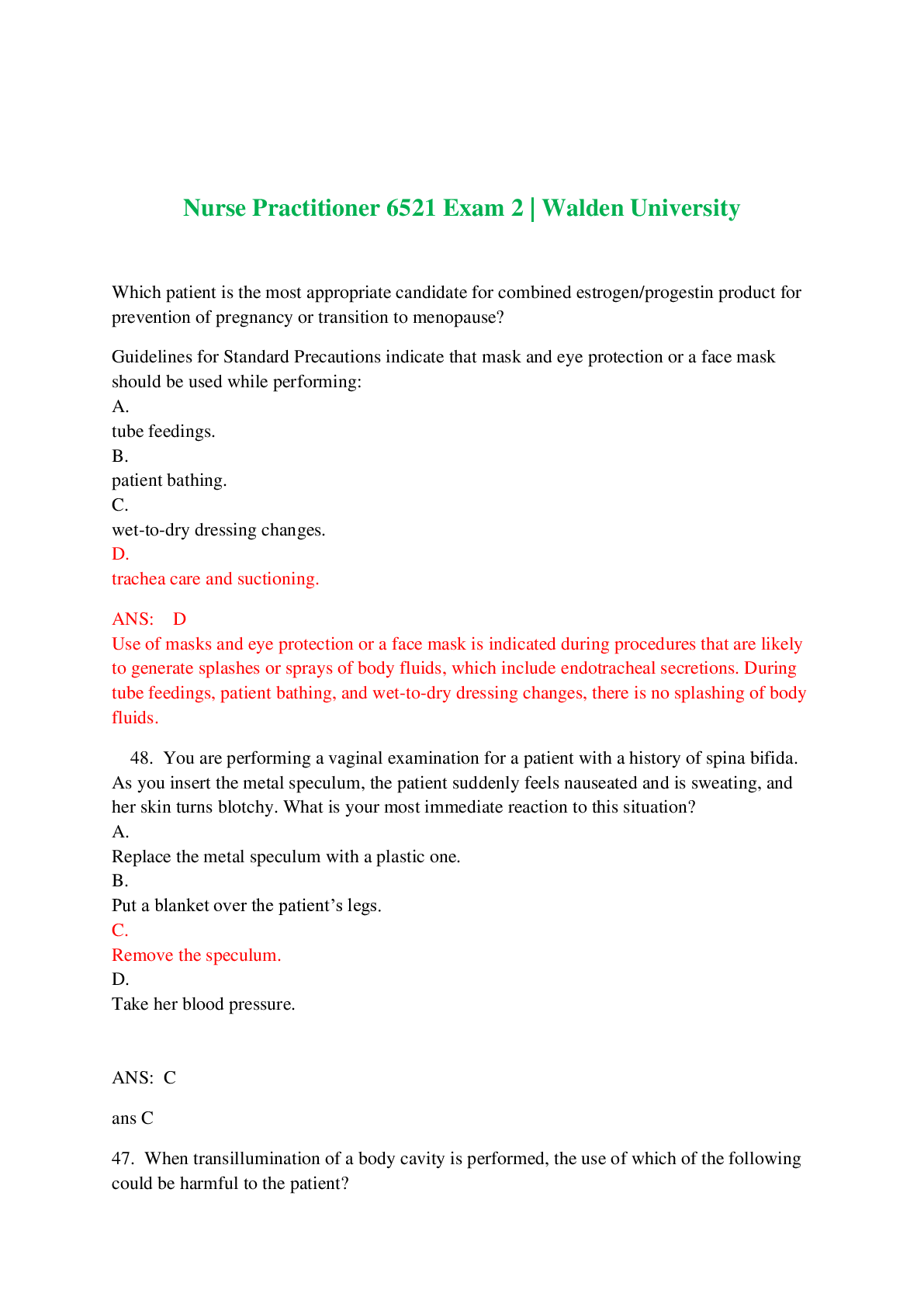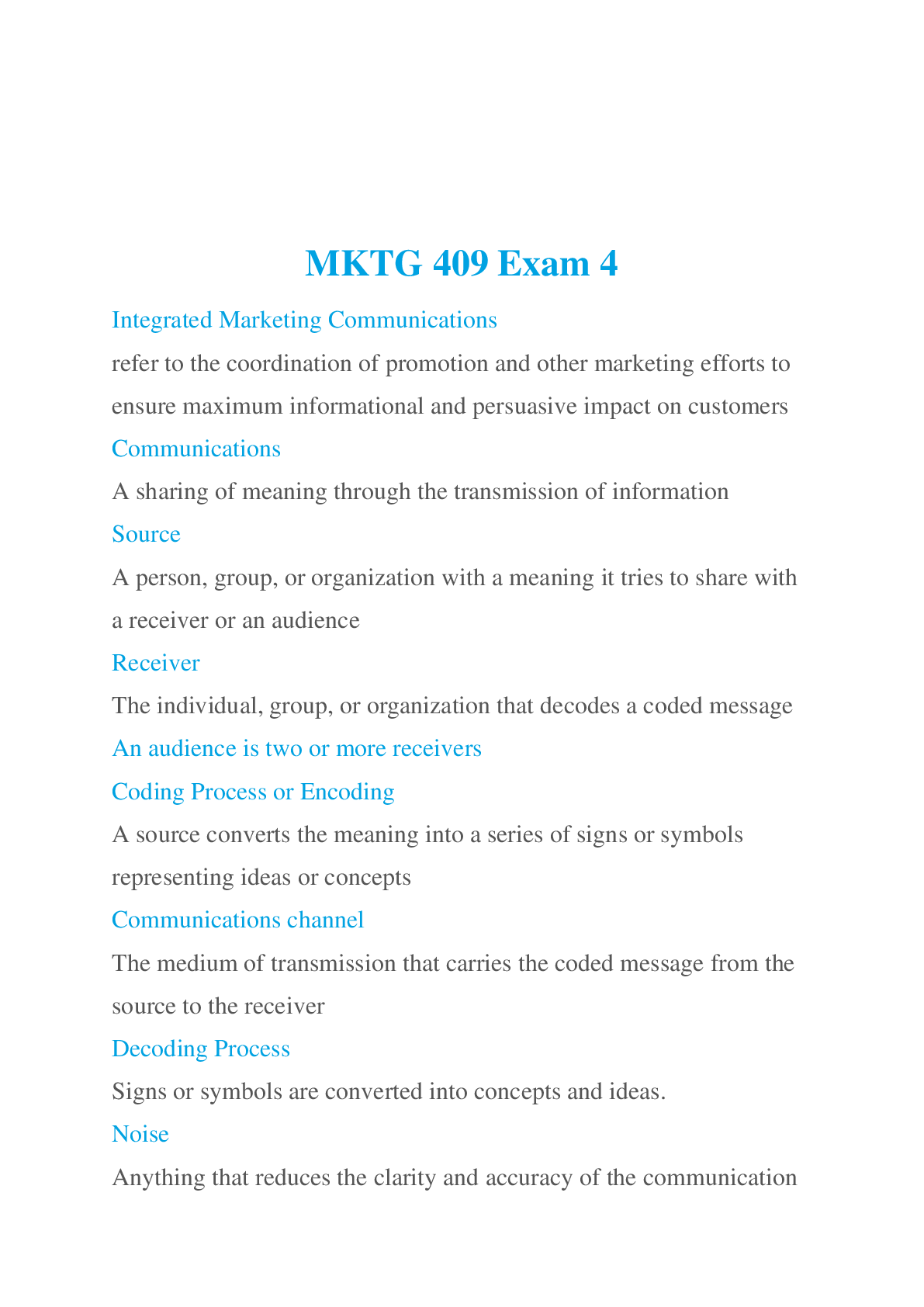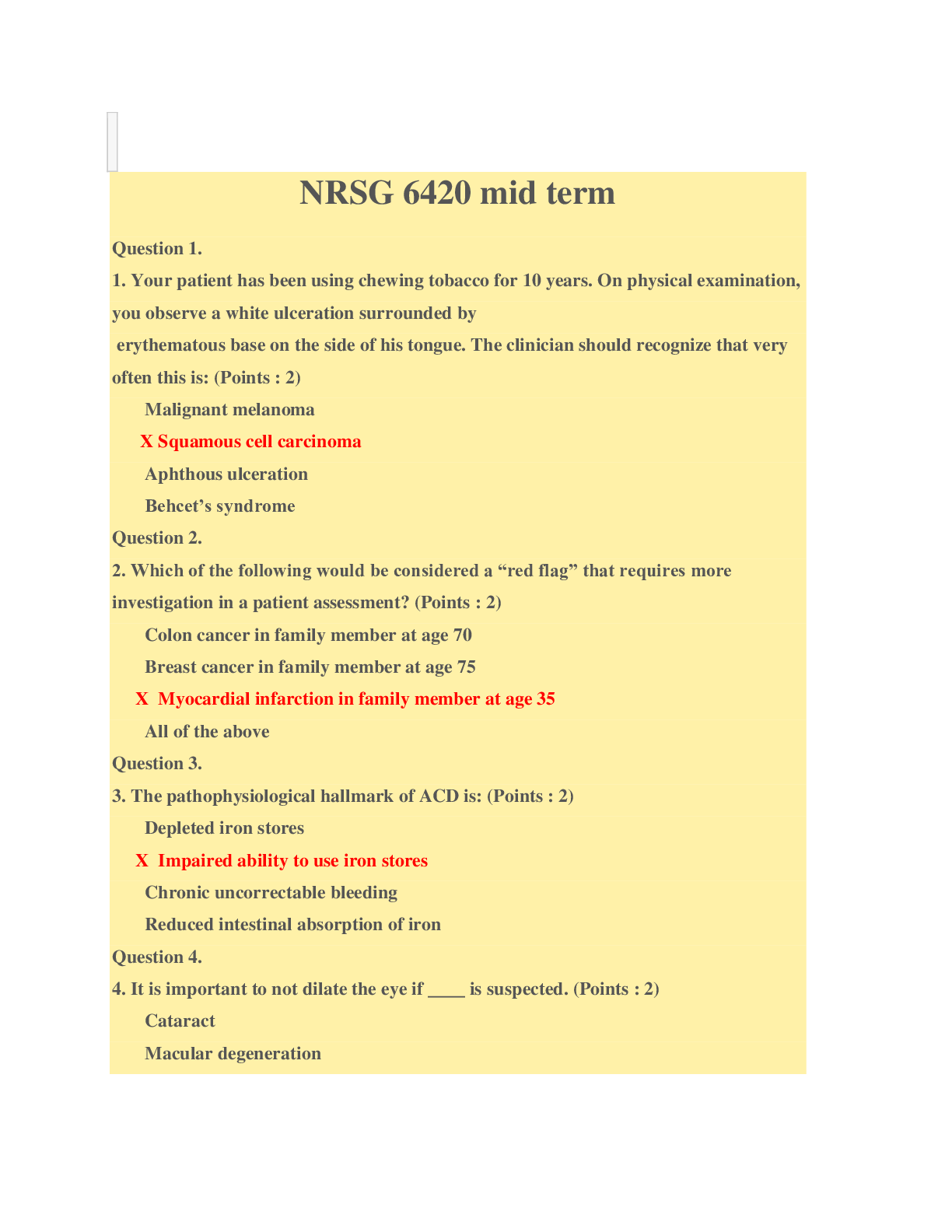ATI_Concept_Base_3 Cellular Regulation
Document Content and Description Below
Cellular Regulation: Ch. 89 General Principles of Cancer Risk Factors: ● Age; older higher risk ● Race ● Genetics ● Exposure to chemicals, tobacco & alcohol ● High fat, red meat, & lo... w fiber ● Exposure to sun, UV, & radiation Staging ● T: tumor higher number bigger tumor ● N: node # of lymph nodes involved ● M: Metastasis: 0 no evidence 1 evidence Risk for malnutrition ● Hypermetabolic state due to presence of carcinoma ● Impair ability to ingest, digest, absorb nutrients Ch. 90 Cancer Screening & Diagnostic Procedures C: change in bowel or bladder habits A sore that doesn’t heal Unusual bleeding or discharge Thickening or lump of breast or elsewhere Indigestion or difficulty swallowing Obvious changes in warts or moles Nagging cough or hoarseness Diagnostics: ● Biopsy provides definitive diagnosis ● Imaging secondary tool; CT, MRI, PET scan, or ultrasound Ch. 91 Cancer Treatment Options ● Remove tumor: tumor excision ● Chemotherapy: damages cell’s DNA or destroys rapidly dividing cells ○ Unintentional harm to normal rapidly proliferating cells ■ Hair, mucous membranes in GI, & bone marrow ○ Implanted port or central catheter ■ High risk for infection Protect & teach ■ Monitor VS temp 100F reported right away & WBC <1000 Neutropenic precautions ● Colony stimulating production ● Avoid crowds,, changing litter box,, avoid yard work & gardening, avoid room temp drinks sitting for more than 1 hr, ● Dishes washed in hot soapy water in dishwasher ● Toothbrushes washed daily don’t share personal items ● Avoid food containing bacteria fresh fruits & vegetable, undercooked meat, fish & eggs, pepper & paprika ○ Administer antiemetic meds ■ Prior, during, afterwards ■ Smells or supplies triggering nausea remove from room ■ Meds to improve appetite & mouth care prior to meals ■ Avoid drinking liquids while eating, inbetween, ○ High protein high calorie & nutrient dense diet & supplement ○ Alopecia ■ 7-10 after initiation to chemo ○ Mucositis: inflammation of tissues in mouth ■ Avoid glycerin based mouthwash or mouth swabs ■ Non alcoholic anesthetic mouthwashes recommended ■ Avoid salty acidic or spicy foods ■ Offer oral hygiene before & after meals ■ Moisturizing agent to counteract dry mouth ■ Use half saline half peroxide rise 2x a week ■ Soft bristled toothbrush ■ Diet bland & soft ○ Anemia & Thrombocytopenia ■ Monitor for s/s: fatigue, pallor, SOB ■ Provide frequent rest periods ■ Administer Epoetin alfa & ferrous sulfate = improve iron levels ■ Monitor for blood in stool, urine, & vomit ■ Monitor for petechiae, ecchymosis, bleeding of gums, nosebleeds ■ Avoid IV, injections taking blood if so apply pressure 10mins ■ Encourage electric razor ■ Soft bristled toothbrush ■ Avoid blowing nose vigorously ■ Administer thrombopoietic meds OPRELVEKIN ■ Avoid NSAIDs and prevent injury ● Radiation Therapy: ○ Skin marked with tattoos to help guide positioning of external radiation ○ Skin care ■ Gently wash skin mild soap & water ■ DON’T apply powder, ointment, lotion, perfumes, deodorant ■ Soft clothing avoid tight and constricted ■ No sun or heat source of site ● Hormonal therapy: ○ Estrogen dependent cancer ○ Tamoxifen ● Immunotherapy ○ Interleukins & interferons Ch. 92 Cancer Disorders ❖ Skin cancer ➢ Leading cause: sunlight exposure ■ Squamous cell cancer rough scaly type lesion ■ Basal cell cancer small waxy nodule most common ■ Melanoma: cancer of melanocytes ➢ ABCDE: asymmetry, border, color, diameter, evolving ➢ s/s: irregular shape & border w/ multiple colors, new moles or change in existing moe, itching, cracks, ulceration, & bleeding (possible) ➢ Treatment: liquid nitrogen to freeze it, topical chemotherapy 5 fluorouracil cream ➢ Prevention: limit exposure to sunlight, apply sunscreen, use sunblock, avoid indoor tanning, wear protective clothing ❖ Leukemia: ➢ Cancer of WBCs; invade and destroy bone marrow, overgrowth of leukemic cells prevents growth of other blood components such as platelets and RBC ■ Risk for infection & bleeding ❖ Lymphoma: ➢ Cancer of lymphocytes ❖ Nursing care: no fresh fruits & vegetables, no visitors who are sick, prevent injury ❖ Treatment: Chemo, radiatio, bone marrow transplant ➢ Report manifestations of infections or illness immediately to provider ➢ The nurse should instruct the client to wash drinking glasses after each use to remove bacteria, which can be harmful to a client who is immunocompromised. ❖ Thyroid cancer ➢ Risk factors: females, diet low in iodine, radiation exposure ➢ Assessment: change in shape or size warning sign & palpable nodules ➢ Nursing care: airway patency, swallowing assessment ➢ Treatment: thyroidectomy, radioactive iodine ❖ Lung Cancer ➢ Prognosis poor diagnosed in advanced stage ➢ Risk factors: smoking biggest risk factor ➢ S/S: cough, dyspnea, hoarseness ➢ Calculate pack yr history ■ # of packs per days X years they smokes = pack year ■ Evaluate use of pipes, chewing tobacco, & cigars ❖ Colorectal cancer ➢ Polyp benign and left untreated becomes cancerous ➢ Key symptom: blood in stool ➢ Colonoscopy screening start at age 50 be done every 10 yrs, unless found polyps ➢ Annual fecal occult blood testing FOBT 50-75 yrs ❖ Breast cancer ➢ Risk factors: relative, early menarche (early/late periods/menopause), prolonged use of oral contraceptives, smoking, Hormone replacement therapy, obesity ➢ Assessment: skin changes (orange peel), dimpling, small firm non-tender, non-mobile bumps, nipple discharge, nipple retraction or ulceration ➢ Treatment: hormone therapy ■ Medications: SERMs tamoxifen & raloxifen ■ chemo/radiation ■ Surgical interventions ➢ Nursing care: ■ Wear sling while ambulating ■ Avoid administrating injections, taking BP, or obtaining blood from affected extremity ■ Early arm & hand exercises to regain full range of motion ■ Don’t wear constrictive clothing ❖ Cervical cancer ➢ Infection with HPV ➢ Prevention: vaccinated with HPV vaccines, ➢ PAP screening should occur by 21 yrs of age or three yrs. Following first sexual intercourse ❖ Prostate cancer ➢ Risk factors: African Americans, high fat diet, ➢ S/S: urinary hesitancy, bladder infections, urinary retention, blood in urine, residual urine after voiding ➢ Assessment: PSA, digital rectal exam, PSA first before rectal, ■ Elevation more than 4 ➢ Prostate screening after age 50 ➢ Meds: leuprolide luteinizing hormone releasing hormone Ch. 93 Pain Management for Clients Who Have Cancer Palliative care: manage pain levels & improve symptoms ● More comfortable ● Meds: nonopioids, opioids, antidepressants & anticonvulsant neuropathic pain relieve, steroids, skeletal muscle relaxers, systemic anesthetic PCA pump, topical local anesthetics, regional nerve blocks ● TENS, imagery, application of hot or cold, hypnosis, acupuncture Hospice care: end of life Ch. 40 Nursing Care of Children Blood Neoplasm Leukemia: causes of production of immature WBC Most common form of cancer in childhood Causes: anemia, thrombocytopenia, neutropenia, immature WBC Diagnosis: ● bone marrow aspiration or biopsy, provide topical anesthetic 1 hr prior to procedure ● CSF analysis ● Lumbar puncture: empty bladder, topical 1 hr cream, side lying, head flexed and knees towards chest ● After procedure lay flat 4-8 hrs. Mucosal ulceration prevention ● Soft-bristled toothbrush ● Lubricate lip balm ● Soft bland diet ● Don’t use viscous lidocaine, hydrogen peroxide, lemon glycerin swabs, & milk of magnesia, avoid rectal temp Immunity CHAPTER 2 Emergency Nrsg. Principles & Mgmt Triage Classes I. RED-emergent II. YELLOW-urgent III. GREEN-non-urgent IV. BLACK-expectant Priority framework ABCDE principle ● Airway ● Breathing ● Circulation ● Disability (LOC, coma) ● Exposure Head lift chin tilt maneuver DON’T use w/ pts who have fractures in their cervical spine!!! Accidental poisoning TX: ● Activated charcoal ● Gastric lavage ● Whole bowel irrigation Don’t induce vomiting! Don’t give Ipecac (This was an old standard no longer doing this) RAPID RESPONSE—-> If patient rapidly declining Cardiac emergencies ● V fib ● V tach Initiate BLS & CPR, IVs ○ TX’s ■ Epinephrine ■ Amiodarone ■ Lidocaine ■ Mg+ ■ Procainamide ■ Vasopressin ■ Dobutamine (Beta1, increased HR, for HF) KNOW YOUR RECEPTORS!!!! (It helps with figuring out side effects!) ACTIVATION CAUSES…. ● ALPHA 1 (skin, mucous membranes, and blood vessels to constrict. Increases BP ● BETA 1 (heart) & BETA 2 (Lungs) ● DOPAMINE- (shock & HF)-Renal blood vessels dilate. Ch. 5 Anaphylactic reaction A life‑threatening, immediate allergic reaction that causes respiratory distress, severe bronchospasm, laryngeal edema, a quick drop in blood pressure, as well as cardiovascular collapse. NURSING CONSIDERATIONS: Treat with epinephrine, bronchodilators, and antihistamines. Provide respiratory support, and inform the provider The nurse should instruct the client to first remove the activation cap from the epinephrine injector. The client should then forcefully insert the injector into the outer aspect of the thigh and hold the epinephrine injector in place for 10 seconds. Following the removal of the injector, the client should massage the injection site for 10 seconds. Finally, the client should ensure that the needle is projecting through the tip of the device. This indicates the medication was injected. Following examination of the pen, the client should seek immediate medical attention, because the therapeutic effects of the epinephrine injector begin to subside within 10 to 20 min. CHAPTER 10 MULTIPLE SCLEROSIS (& other Autoimmune disorders, ALS, Myasthenia Gravis) PATHO ● plaque in the white matter of the CNS turn damages the myelin sheath which interferes with impulse transmission between the CNS and the rest of the body disease there's no known cure ● it usually afflicts people between the ages of 20 and 40 and mostly women ● the normal course for MS is periods of relapsing and periods of remitting and different things can cause Triggers Viruses, cold climate, physical injuries stress, pregnancy, fatigue, hot baths & shower S/S key symptoms ● Diplopia (double vision) ● Decreased visual acuity ● Tinnitus, decreased hearing acuity ● Dysphasia ● Slurred and nasal speech ● or difficulty swallowing they may ● have a slurred and nasal speech ● muscle spasticity ● Muscle weakness these are really Also may have: nystagmus (rapid mov’t of the eyes) bowel dysfunction urinary incontinence some cognitive changes such as impaired judgment & memory loss sexual dysfunction it's important to know kind of those eye symptoms that your symptoms the swallowing the muscle spasticity the incontinence those are kind of all symptoms of MS in terms of W/ Dx procedures an MRI for a pt will reveal plaques in the brain and the spine and that's one way to Dx MS nursing care MEDs ● cyclosporine which is an immunosuppressive agent and that helps reduce the frequency of relapses in ● prednisone- a steroid which helps decrease inflammation in acute exacerbation ● muscle relaxer-two of the main ones I would know are dantrolene and baclofen, used Tx muscle spasticity in ms ALS A degenerative neurological disorder of the upper & lower lower motor neuron. It basically causes progressive paralysis it usually starts in the extremity & it kind of moves up towards the center of the body it ultimately affects the respiratory muscles which causes respiratory failure & eventually death Death usually occurs via respiratory failure w/in 3 to 5 years of the onset of symptoms. The cause of ALS is unknown there is no cure S/s ● muscle weakness ● muscle atrophy ● Dysphagia Important-keep a patent Airway!! suctioning & intubating PRN-will likely need to happen towards the end of the course of ALS. -pneumonia is a big one and then respiratory failure due to the weakness of the respiratory muscles MEDS ● glutamate antagonist which can help the deterioration of the motor neurons in terms of complications. CHAPTER 23 TB TB is an infectious disease caused by Mycobacterium, that primarily affects the lung parenchyma associated w/ poverty, malnutrition, overcrowding, substandard housing, and inadequate health care.. -transmitted by AIRBORNE, so anytime you suspect that somebody may have TB you want to put them into a negative airflow room right away and you want to wear your n95 mask anytime you go in that room so if you have a patient with TB there's a good chance their family members may have TB too so they will also need to be tested PATHO The bacteria are transmitted through the airways to the alveoli, where they are deposited and begin to multiply. The bacilli also are transported via the lymph system and bloodstream to other parts of the body (kidneys, bones, cerebral cortex) and other areas of the lungs (upper lobes). The body’s immune system responds by initiating an inflammatory reaction. Phagocytes (neutrophils and macrophages) engulf many of the bacteria, and TB-specific lymphocytes lyse (destroy) the bacilli and normal tissue. This tissue reaction results in the accumulation of exudate in the alveoli, causing bronchopneumonia. The initial infection usually occurs 2 to 10 weeks after exposure. RISK FACTORS ● a crowded environment such as a prison or a long-term care facility ● low socioeconomic status ● immunocompromised individuals will also be at higher risk for TB, so if they have HIV or they're receiving chemotherapy and their immune system is compromised ● Being a health care worker performing high-risk activities ● Institutionalization (e.g., long-term care facilities, psychiatric institutions, prisons). ● Pre Existing medical conditions or special treatment (e.g., diabetes, chronic kidney injury, malnourishment, selected malignancies, hemodialysis, transplanted organ, gastrectomy, and jejunoileal bypass). ● Substance abuse (IV/injection drug users and alcoholics). ● Immigration from or recent travel to countries with a high prevalence of TB (southeastern Asia, Africa, Latin America, Caribbean). SYMPTOMS ● a cough that they've had for more than three weeks so persistent cough ● unexplained weight loss ● if they are particularly tired and lethargic ● night sweats is another big symptom of TB ● purlins sputum is also a symptom LABS quantiFeron Gold test which tests blood serum levels skin test(mantoux test)-a small injection in your forearm and then you have it read 48 to 72 hours later by a healthcare provider, if results have an area of induration of 10 ml or bigger that is a positive skin test for TB -If pt has a compromised immune system such as the chemo patient or somebody with AIDS or HIV then a fivemillimeter induration is positive also international patients typically who have received the BCG vaccine this can cause a false positive mantoux test than an x-ray will likely be ordered which will detect active lesions in the lungs, you can also test their sputum (early morning sputum) to see if there's acid-fast bacilli, & you want to collect 3 different samples. MEDS Pts will get four or more medications for a prolonged period of time in order to treat TB and that is due to resistance that has developed against these TB medications you have to kind of hit it from multiple angles so medications will be taken between 6 and 12 months, so explaining the importance of taking these meds and taking it for the entire amount of time!!!! the meds are really important, you know ATI loves to ask questions about those meds: so just remember (RIPE) PT WILL REPORT TO SOMEONE WHO MONITORS THEM, THEY WILL TAKE THE MEDICINE AT EXACTLY THE SAME TIME Q-DAY AND IT IS DOCUMENTED WHEN THEY TAKE IT!!!! ● Rifampin-(hepatotoxicity, interferes w/ oral contraceptives, will causes secretions to turn orange but this is an expected finding) ● Isoniazid -(watch for Neurotoxicity-numbness and tingling in extremities feet & hepatotoxicity- yellowing of the skin and elevated values) ● Pyrazinamide-causes hepatotoxicity ● Ethambutol-sometimes it causes vision problems (remember ethambutol & eyes---both start w/ E) Also Streptomycin -used for used for multidrug-resistant TB so if they've had treatment and hasn't really cured the TB then then they may give them this.(--can cause ototoxicity)they're gonna want to get sputum samples from the patient and they're going to want to get them every two to four weeks then once they have three negative sputum cultures they are considered no longer infectious after that and those are really the main points with TB CHAPTER 52 INFLAMMATORY BOWEL DISEASE (IBD) three conditions -Ulcerative Colitis (UC) -Crohn's disease -diverticulitis So it's really important that you be able to differentiate between ulcerative colitis & Crohn's disease 1ST- UC is where you have edema & inflammation of the rectum and the sigmoid colon the most distal portion of the GI tract, the mucosa and the submucosa are affected with ulcerative colitis and you have lesions that are continuous 2ND-Crohn's-you have ulceration inflammation of, with Crohn's disease all layers of the bowel may become involved anywhere in the GI tract but typically we often see it in the distal as opposed to ulcerative colitis which affected the mucosa and submucosa. In addition, fistulas are pretty common with Crohn's disease and the lesions are sporadic. 3RD-DIVERTICULITIS (Diverticulosis- pt has little outpouchings' from their intestine in which food can get caught in there especially if they eatlike nuts or seeds and stuff and it can become inflamed and it can actually perforate which becomes a medical emergency) DIVERTICULITIS is inflammation of those little pouches. RISKS FACTORS -genetics (Caucasians and those of Jewish heritage) -a diet low in fiber -smoking -autoimmune disorders can place a patient S/s Ulcerative colitis ● pain in the LEFT lower quadrant ● Fever ● abdominal distention & tenderness ● 15 to 20 liquid stools/ day (may contain mucus blood or pus) Crohn's disease ● Pain in the RIGHT lower quadrant ● fever ● Abdominal distension & tenderness ● 5 loose stools/ day (may contain mucus or pus)-less likely to have blood in the stool ● more likely to have steatorrhea (fat in feces) LABS decreased hematocrit (Hct) The nurse should frequently assess the stoma. It should not be prolapsed or retracted into the abdominal wall. The nurse should report these findings to the provider as well as a change in the appearance of the stoma color to pale, bluish, or dark in color. The nurse should expect to administer metronidazole to a client who has diverticulitis. This is a broadspectrum antimicrobial drug and is administered in combination with other antibiotics, such as trimethoprim/sulfamethoxazole or ciprofloxacin. CHAPTER 87 Lupus Erythematosus Lupus Erythematosus is an autoimmune disorder in which an atypical immune response results in chronic, inflammation and destruction of healthy tissue. NO CURE Characterized by periods of exacerbation and periods of remission (flares) Types: ● Discoid Lupus: only affects skin ● Systemic Lupus: affects connective tissue of multiple organ system can lead to organ failure Risk Factors: ● Females 20-40 ● Race: African American, Asian, Native Americans Expected Findings: ● Fatigue/Malaise ● Alopecia (losing hair) ● Joint Pain, swelling, tenderness ● Pleuritic Pain ● Fever (major indication of exacerbation) ● Anemia ● Lymphadenopathy ● Pericarditis (cardiac friction rub or pleural friction) ● Raynaud’s phenomenon (cold or stress vasospasms) ● Butterfly rash Labs: ● Positive ANA test (antinuclear antibodies) ● CBC (Anemia) decreased Medications: ● NSAIDS: inflammation and arthritic pain ● Corticosteroids: immunosuppression to reduce inflammation ● Immunosuppressant agents ● Antimalarial: (hydroxychloroquine) suppression of synovitis, fever, and fatigue Patient Teaching: ● Avoid UV and sun exposure ● Steroid creams for rash ● Report evidence of infection ● Avoid crowds and individuals who are sick Complications ● Renal failure = lupus nephritis ● Pericarditis and myocarditis Ch. 88 Rheumatoid Arthritis Joints bilaterally & symmetrically, autoimmune disease caused by WBC attacking synovial tissue, inflammate & thickened; periods of exacerbations & remessions Risk factors: ● Female ● Ages 20-50 ● Joint deformities > late sign s/s: ● Pain at rest & movement ● Morning stiffness ● Fatigue ● Joint swelling ● Warmth & erythema ● Fingers, hands, wrists, knees, foot joints ● subQ nodules ● Low grade fever ● Reddened sclera or abnormal shape of pupils ● Lymph node enlargement Diagnostics: ● RF antibody: antibody present if RA ● Elevated ESR & C-reactive protein levels ● ANA elevated ● WBC elevated ● Aspirate synovial fluid & X rays Nursing intervention: ● Teaching ○ Hot shower in morning for stiffness ○ Cold therapy for edema ○ Encourage physical activity to maintain joint mobility ○ Conserve energy, take rest periods as needed ○ PT/OT, assisted devices Medications ● NSAID ● Corticosteroids ● DMARS ○ Antimalarial agents The desired effects of this medication include a decrease in joint pain and swelling and improved mobility for clients. ● Cytotoxic: methotrexate Therapeutic procedure Plasmapheresis: remove circulating antibody from plasma sjogren’s syndrome: triad of symptoms Dry mouth, nose, and vagina Intracranial Regulation Ch. 6 Seizures Uncontrolled electrical discharge of neurons in the brain Causes: decreased LOC & motor & sensory changes in the body Epilepsy > recurrent abnormal electrical activity chronic seizures ( 2 or more) Risk Factors: ● Genetics ● Fever <2 yrs. Old ● Head trauma ● Cerebral edema ● Infection = meningitis ● Metabolic disorder ○ Hypoglycemia, & hyponatremia ● Exposure to toxins ● Tumor ● Hypoxia ● alcohol/drug withdrawals ● Fluid & lyte imbalances Other triggers ● Excessive stress ● Overwhelming fatigue ● Caffeine ● Flashing lights Types of seizures ● Generalized seizures (tonic-clonic) sometimes begins with aura (alteration vision or sensory or emotional feel) ● Tonic episode: stiffening of muscles, LOC ● Clonic episode: 1-2 min rhythmic jerking of extremities ● Prostictal phase: confusion, sleepiness *occassionally only tonic or clonic seizure ● Absence: more common in school-aged children ○ Loss of consciousness for few secs. ○ Key features: blank staring, eye fluttering, lip smacking, picking at clothes ● Myoclonic: brief stiffenic of extremities ● Atonic: loss of muscle tone, results in falling ● Status epilepticus: repeated seizure activity within 30 mins or single seizure >5mins Diagnosis: ● EEG: origin of seizure ● CAT scan ● MRI ● Sample of CSF check for infection Nursing interventions: ➔ Standing gently lower to ground ➔ During: ◆ turn patient to side ◆ Move furniture ◆ Loosen restrictive clothing ◆ Do not insert anything in airway ◆ Do not restrain ◆ NO TONGUE BLADE ◆ Document onset/duration ➔ Post: ◆ Keep side lying position ◆ Check VS ◆ Neurologic checks ◆ Reorient ◆ Place on seizure precaution ◆ Try to determine trigger Medications: ● Antiepileptic drugs = phenytoin ○ Periodic blood checks = keep lab appt ○ Side effects: oral gum overgrowth or gingival hyperplasia ○ Interactions with other meds: decrease effect of oral contraceptives & coumadin or warfarin ○ The nurse should instruct the client to monitor for the adverse effect of blurred vision or double vision while taking carbamazepine and report the occurrence of these findings to the provider. Surgical Tx: ● vagal nerve stimulator = hold magnet over iplant, don’t have MRI & microwave ovens, ● surgical removal or interruption of tissue ● Wear medical ID ● Crainiotomy Complications: Status epilepticus: prolonged seizure activity over 30 mins ● Protect airway ● Iv access ● EKG ● Pulse ox ● Meds: valium/diazepan or lorezapam ● Continuous infusion of phenytoin > help stop seizing Parkinson’s Disease Affects motor function ACH too high Dopamine too low Substantia nigra degenerates and production of dopamine decreases, allows ACH to be too high which stimulates the basal ganglia Main s/s: ● Tremor ● Rigidity ● Bradykinesia ● Postural instability Other s/s: ● Slow & shuffling gain ● Mask like expression ● Dysphagia (difficulty chew/swallow) Considerations: ● Drooling ● Difficulty with ADLs ● Mood swings ● Cognitive impairment **diagnostic made based on symptoms** Nursing Care: ➔ Monitor swallowing; maintain adequate nutrition ◆ Use thickener ➔ Encourage exercise & ROM (active or passive) ◆ Yoga ➔ Slow down speed to reduce risk of injury ➔ Speak slowly ➔ Use alternate forms of communication Medications: ● Levodopa: often combined w/ carbodopa ○ Increases dopamine levels in body when combined you can use lovodopa to get effect = less side effects ○ Often weaning off period; drug loses efficacy ○ Medication holiday= need to reestablish effectiveness ● Anticholinergics: decrease ACH ○ Side effects: cant spit, cant piss, cant shit ■ Dry mouth, urinary retention, constipation Complications Aspiration pneumonia: swallowing difficulties ● Attendance while eating ● Suction equipment ● Upright position Ch. 5 Meningitis Inflammation of the meninges; membranes that surround brain or spinal cord viral (clear): more common; resolves w/o treatment bacterial (cloudy): could be deadly; contagious, ABx Prevention: Hib, MCB4 Teens before leaving college, close crowded living S/S: ● Excruciating HA ● Neck stiffness ● Photophobia (pain associated with light) ● Fevers & chills ● N/V ● Altered LOC ● Positive Kerning’s sign: try to straighten leg, knee bent & try to extend ● Positive Brudzinski: neck flex straighten leg ● Tachycardia ● Rash ● Seizures Ch. 9 Brain tumors Often hypothalamus in brain can become damage which can lead to SIADH & DI Risk Factors: Comfort Ch. 10 Multiple Sclerosis Ch. 11 Labor & Delivery Processes ❖ Physiologic changes preceding labor ➢ Backache ➢ Weight loss right before 1-3 lbs. ➢ Lightening: fetus has dropped ➢ Contractions: regular & increase in strength ➢ Bloody show ➢ Energy burst ➢ GI changes: ➢ Rupture of membranes ➢ Assessments: ■ Nitrazine paper ■ Group b streptococcus: ■ urinalysis Stages of labor: ● 1st stage: onset - complete dilation ○ Latent: 0-3 cm talkative & eager ○ Active: over 3-7 cm restless, anxious, feeling of helplessness ○ Transition: over 7-10cm can’t continue, might feel like BM, feeling to push ● 2nd stage: complete dilation - delivery ● 3rd stage: delivery of baby - delivery of placenta ● 4th stage: delivery of placenta - maternal baseline VS Ch. 12 Pain Management Nonpharmacologic: ● effleurage: light gentle circular stroking of client’s abdomen with fingertips ● Sacral counterpressure: heel of hand push against sacral area Opioids ● Risk of respiratory depression of baby ● Sedation ● Hypotension ● Decreased variabiltiy in FHR Epidural ● Lack of sensation at level of umbilicus to thigh; dilated >4cm ● Side effects: maternal hypotension & fetal bradycardia ● IV bolus of fluid, avoid supine hypotension syndrome; laying on side Spinal block: ● Used during C-sections ● Lack of sensation from nipples to feet ● Side effects: maternal hypotension & fetal bradycardia; potential HA, indident of bladder atony Ch. 13 Fetal Assessment During Labor FHR monitoring 110-160 bpm Want moderate variability Early no big deal ● Acceleration OK! ● Early decelerations OK! ○ Compression of fetal head during contraction ● Fetal bradycardia due to epidural or anesthetic; or utero placental insufficiency; ○ Discontinue oxytocin, side lying, more O2, notify provider ● Fetal tachycardia maternal infection, antipyretics, O2 ● Late decelerations not Ok! Lack of fetal oxygenation; utero placental insufficiency ○ Side lying ○ Increase IV fluids ○ Adminster O2, ○ Discontinue oxytocin ○ Notify provider ● Variable decelerations; umbilical cord compression ○ Side lying or knee chest ○ Discontinue oxytocin ○ Adminster O2 Ch.14 Ch.15 Ch. 22 Postpartum Depression Postpartum blues: are very common, last up to 10 days. ● Tearfulness ● Insomnia ● Lack of appetite ● Feeling of “letdown” Resolves without intervention Postpartum Depression: occurs within 6 months of delivery ● Persistent feelings of sadness ● Intense mood swings ● Lack of appetite ● Rejection of infant ● Flat affect ● anxiety/panic attacks Requires intervention Postpartum psychosis: common with moms with history of bipolar disease (key risk factor) ● Disorientation ● Hallucination ● Obsessive behaviors ● Paranoia ● Infant at risk for harm Ch. 13 Depressive Disorders Risk Factors: ● Family hx ● Females between 15-40 ● Patients over 65 ● Medical illness ● Negative life event ● Substance use disorder ● Being single s/sx: ● Anergia (lack of energy) ● Anhedonia (lack of pleasure) ● Anorexia ● Lack of appetite ● Fatigue ● Flat facial expression ● Poor grooming & hygiene ● Slow thinking & speech ● Indecisiveness ● Psychomotor changes A = lack of Types of depressive disorders: ● Major Depressive Disorder MDD ○ Symptoms occur every day ○ At least two weeks ○ 5 of following symptoms ■ Depressed mood ■ insomnia/excess sleep ■ Difficulty concentrating ■ Indecisiveness ■ Suicide ideation ■ A ■ Weight loss or gain 5% ■ Psychomotor ■ Slow response time ● Seasonal affective disorder SAD ○ Winter, gray cold never sunny ○ Light therapy first line of treatment ● Dysthymic disorder ○ Mild form ○ Usually childhood childhood ○ At least 3 ● Premenstrual dysphoric disorder PMDD ○ Luteal phase of menstrual cycle ○ Rapid mood swings ○ Anergia ○ Overeating ○ Difficulty concentrating Phases of MDD Acute phase: exhibiting severe symptoms, last about 6-12 wks Hospitalization needed, risk of suicide greatest, 1-1 observation Goal: treat and reduce depressive manifestations Continuation phase: increased ability to function, last 4-9 months, goal: to prevent relapse, medication therapy and psychotherapy Maintenance phase: remission, last for 1 or more year, Goal to prevent future depressive episodes Nursing care: ● Priority assess suicide risk: implement 1:1 observation ● Do not want in private room need to have roommate ● Communicate simple sentences, allow extra time for their response, due to slow thinking and indecisiveness ● Provide meds as ordered ○ SSRIs, SNRIs, tricyclic antidepressants, MAOI, alternative therapies such as St. John’s wort ● Suicidal ideations: increased energy to carry out plan after 1 week of treatment, Brain stimulation: ECT, TMS, VNS Ch. 14 Bipolar Disorder Mood disorder with recurrent episodes of depression & mania 3 different behaviors: ● Mania: excessive elevated mood,last 1 week, hospitalization needed ● Hypomania: less severe form of mania, no hospitalization ● Rapid cycle: 4 or more episodes of hypomania or mania within 1 yr. Types: Type 1: 1 episode of mania alternating with major depression Type 2: 1 or more hypomania alternating with major depression Cyclothymic: least 2 years of repeated hypomania manifestations that does not meet criteria for hypomania episodes alternating with minor depression episodes Risk factors: ● Genetics ● Psychological stressors ● Neurological disorders ● Substance use disorders s/sx: ● Mania: ○ Mood swings ○ Restlessness ○ Flight of ideas ○ Pressure speech ○ grandiosity ○ Poor judgement ○ impulsiveness ○ Decreased attention span ○ Insomnia ○ Neglect of ADLs eating, drinking ○ Possible hallucinations ● Depressive s/sx ○ Anergia (lack of energy) ○ Anhedonia (lack of pleasure) ○ Anorexia ○ Lack of appetite ○ Fatigue ○ Flat facial expression ○ Poor grooming & hygiene ○ Slow thinking & speech ○ Indecisiveness ○ Psychomotor changes Nursing care: ● Safe environment ○ Protect pt of poor judgment ○ Decrease stimulation ○ 1:1 observation ○ Risk of harm = restraints ● Frequent rest periods ● Monitor sleep, food, & fluid intake ● Provide high calorie snacks ● Set limits, calm explains Medications for Bipolar Disease ★ Mood stabilizers ○ Lithium: ■ Side effects: GI upset common, fine hand tremors very common, course tremors is sign of toxicity, polyuria, weight gain, lyte imbalance, kidney toxicity ■ Monitor blood levels over 1.5 possible toxicity ● Coarse tremors, confusion, hypotension, seizure, coma, tinitus ■ Don’t take diuretics, anticholinergics, NSAIDs, ■ Important of fluid intake ■ Contraindicated with renal failure ■ Monitor sodium levels, encourage drinking fluids, and sodium intake ○ Antiepileptics: ■ Carbamazepine, valproic acid (valproate) , lamotrigine ● Anticonvulsive & bipolar disorders ● Carbamazepine Side effects: blood discrasias: can cause anemia, leukopenia, thrombocytopenia, risk for bleeding and infections, vision problem, ● Valproate side effects: hepatotoxicity, GI upset, pancreatitis, thrombocytopenia Ch. 22 Medications for Depressions ★ Tricyclic antidepressants: ○ Amitriptyline ■ Amy tripped over a tricycle in the dessert ■ Indications: depression, neuropathy, fibermyalgia ■ Side effects: anticholinergic side effects ● Photophobia, urinary retention, dry mouth, constipation, tachycarda ● Cant see cant pee cant spit cant shit ● Sedation, sweating, seizures, ● Orthostatic hypotension ■ Chew gum, wear sunglasses, high fiber diet, increase fluid ★ MAOIs: ○ Phenelzine, trenesalfomine ■ Indications: depression ■ Side effects: agitation anxiety, ortho hypotension, hypertensive crisis, ■ Interact with almost every other medications, OTC ■ Patients should not eat food rich in thymine ● Aged cheese, avocados, bananas, salami, red wine, chocolate, ★ Atypical antidepressants: ○ Bupropion ■ Treating depression & aid to stop smoking ■ Be appropriate and don’t smoke ■ Side effects: insomnia, HA, stomach upset, agitation, weight loss ○ Trazadone ■ Side effect: sedation ★ SSRIs Selective Serotonin reuptake inhibitors: ○ Fluoxetine, paraxotine (teens cause anxiety & depression) ○ Mode of action: increases levels of serotonin ○ Side effects: sexual dysfunction, insomnia, weight gain ○ Monitor for s/s Serotonin syndrome: agitation hallucination, fever, diaphoresis, & tremors don’t take with St. John’s wort ○ Full effects take about a month ★ SNRIs Serotonin norepinephrine reuptake inhibitors ○ Venlafaxine, duloxetine ■ Inhibit reuptake of serotonin & norepinephrine ■ Used to treat depression ○ Side effects: HA, Nausea, agitation, possible anorexia, weight loss, hyponatremia, sexual dysfunction ○ Advise: avoid alcohol & hepatic disease avoid duloxetine don’t take with St. John’s wort Ch. 30 Suicide Risk factors: ● Untreated depression or other mental illness ● family history ● Prior suicide attempt ● Chronic health problem ● Substance use disorder ● Loss of job or loved one ● Cultures: american indian & alaskan Protective factors: ● Religious beliefs ● Strong support network ● Effective coping skills ● Access to health care Assessment: ● Does that patient has a plan? How lethal? Access to intended method? ● Ask they are thinking of hurting themselves? Nursing interventions ● 1:1 constant supervision right at admission ● Document pt behavior q15 mins. ● Search pt belonging at admission ● Remove dangerous objects ● Only allow plastic silverware ● No private room ● Ask agree to no suicide contract ● Medications swallow all meds, open mouth ● Recognize behaviors: giving away possessions, sudden change in mood, surege in energy, showing appreciation for love ones, affairs in order Ch. 6 Seizures Uncontrolled electrical discharge of neurons in the brain Causes: decreased LOC & motor & sensory changes in the body Epilepsy > recurrent abnormal electrical activity chronic seizures ( 2 or more) Risk Factors: ● Genetics ● Fever <2 yrs. Old ● Head trauma ● Cerebral edema ● Infection = meningitis ● Metabolic disorder ○ Hypoglycemia, & hyponatremia ● Exposure to toxins ● Tumor ● Hypoxia ● alcohol/drug withdrawals ● Fluid & lyte imbalances Other triggers ● Excessive stress ● Overwhelming fatigue ● Caffeine ● Flashing lights Types of seizures ● Generalized seizures (tonic-clonic) sometimes begins with aura (alteration vision or sensory or emotional feel) ● Tonic episode: stiffening of muscles, LOC ● Clonic episode: 1-2 min rhythmic jerking of extremities ● Prostictal phase: confusion, sleepiness *occassionally only tonic or clonic seizure ● Absence: more common in school-aged children ○ Loss of consciousness for few secs. ○ Key features: blank staring, eye fluttering, lip smacking, picking at clothes ● Myoclonic: brief stiffenic of extremities ● Atonic: loss of muscle tone, results in falling ● Status epilepticus: repeated seizure activity within 30 mins or single seizure >5mins Diagnosis: ● EEG: origin of seizure ● CAT scan ● MRI ● Sample of CSF check for infection Nursing interventions: ➔ Standing gently lower to ground ➔ During: ◆ turn patient to side ◆ Move furniture ◆ Loosen restrictive clothing ◆ Do not insert anything in airway ◆ Do not restrain ◆ NO TONGUE BLADE ◆ Document onset/duration ➔ Post: ◆ Keep side lying position ◆ Check VS ◆ Neurologic checks ◆ Reorient ◆ Place on seizure precaution ◆ Try to determine trigger Medications: ● Antiepileptic drugs = phenytoin ○ Periodic blood checks = keep lab appt ○ Side effects: oral gum overgrowth or gingival hyperplasia ○ Interactions with other meds: decrease effect of oral contraceptives & coumadin or warfarin Surgical Tx: ● vagal nerve stimulator = hold magnet over iplant, don’t have MRI & microwave ovens, ● surgical removal or interruption of tissue ● Wear medical ID ● Crainiotomy Complications: Status epilepticus: prolonged seizure activity over 30 mins ● Protect airway ● Iv access ● EKG ● Pulse ox ● Meds: valium/diazepan or lorezapam ● Continuous infusion of phenytoin > help stop seizing Parkinson’s Disease Affects motor function ACH too high Dopamine too low Substantia nigra degenerates and production of dopamine decreases, allows ACH to be too high which stimulates the basal ganglia Main s/s: ● Tremor ● Rigidity ● Bradykinesia ● Postural instability Other s/s: ● Slow & shuffling gain ● Mask like expression ● Dysphagia (difficulty chew/swallow) Considerations: ● Drooling ● Difficulty with ADLs ● Mood swings ● Cognitive impairment **diagnostic made based on symptoms** Nursing Care: ➔ Monitor swallowing; maintain adequate nutrition ◆ Use thickener ➔ Encourage exercise & ROM (active or passive) ◆ Yoga ➔ Slow down speed to reduce risk of injury ➔ Speak slowly ➔ Use alternate forms of communication Medications: ● Levodopa: often combined w/ carbodopa ○ Increases dopamine levels in body when combined you can use lovodopa to get effect = less side effects ○ Often weaning off period; drug loses efficacy ○ Medication holiday= need to reestablish effectiveness ● Anticholinergics: decrease ACH ○ Side effects: cant spit, cant piss, cant shit ■ Dry mouth, urinary retention, constipation Complications Aspiration pneumonia: swallowing difficulties ● Attendance while eating ● Suction equipment ● Upright position Ch. 5 Meningitis Inflammation of the meninges; membranes that surround brain or spinal cord viral (clear): more common; resolves w/o treatment bacterial (cloudy): could be deadly; contagious, ABx Prevention: Hib, MCB4 Teens before leaving college, close crowded living S/S: ● Excruciating HA ● Neck stiffness ● Photophobia (pain associated with light) ● Fevers & chills ● N/V ● Altered LOC ● Positive Kerning’s sign: try to straighten leg, knee bent & try to extend ● Positive Brudzinski: neck flex straighten leg ● Tachycardia ● Rash ● Seizures Myasthenia Gravis (MG) PATHO causes muscle weakness and is associated w/ antibodies that prevent the uptake of ACh at the neuromuscular Junction, like MS pts. W/ MG pts have periods of exasperation or remissionsome. things that can cause exasperation of MG include: fatigue ● illness ● pregnancy ● hot water like with a hot tub ● infection Pts w/ MG have hyperplasia of the thymus glands (enlargement) of the thymus gland S/s (are similar to MS) ● muscle weakness ● diplopia or double vision ● difficulty chewing and swallowing ● respiratory function ● bowel and bladder dysfunction unique s/s include drooping eyelids so definitely remember that !! exasperation mimics the symptoms of a cholinergic crisis( Both have muscle weakness & impaired respiratory function in order to determine if pt has exasperation MG or cholinergic crisis, pt is given medication called Tensilon (Edrophonium) to increases the amount of ACh at the neuromuscular Junction and by increasing the amount of ACh -if their symptoms improve that means that they were having an exacerbation of myasthenia gravis however if their symptoms worsen than they were probably having a cholinergic crisis It's important to have on hand, when you do this test is atropine which is the antidote for tensilon you would give it to them if they are in fact having a cholinergic crisis so after the diagnosis again you're going to ● use ABCs ● maintain a patent airway y ● make sure that you have oxygen intubation & suctioning equipment nearby ● allow for periods of rest, fatigue and activity will worsen ● the symptoms of MG ● Provide small frequent high calorie meals ● Have the pt sit upright ● May need to add thickeners to their foods ● Provide lubricating eye drops ● you may need to patch or tape their eyelid shut in order to prevent damage to the cornea so this is MEDS ● Pyridostigmine (Mestinon) ● neostigmine -can help improve muscle strength and it inhibits the break up of ACh at that neuromuscular Junction in addition immunosuppressants may be used for pts Finally a therapeutic procedure is plasmapheresis which removes those antibodies in the plasma, which will help improve symptoms. -have oral nasal suctioning equipment at the bedside The client who has myasthenia gravis is at risk for aspiration because of progressive weakness of the oropharyngeal muscles. Myasthenia gravis causes muscle weakness due to an autoimmune disease that affects the acetylcholine receptors. The nurse should place oxygen and oral-nasal suction equipment at the bedside in the event of aspiration or respiratory distress. Sx interventions Thymectomy-removal of the thymus gland and that can help the doctors have better control over the symptoms and may allow the patient to go into complete remission CHAPTER 87 Lupus Erythematosus Lupus Erythematosus is an autoimmune disorder in which an atypical immune response results in chronic, inflammation and destruction of healthy tissue. NO CURE Characterized by periods of exacerbation and periods of remission (flares) Types: ● Discoid Lupus: only affects skin ● Systemic Lupus: affects connective tissue of multiple organ system can lead to organ failure Risk Factors: ● Females 20-40 ● Race: African American, Asian, Native Americans Expected Findings: ● Fatigue/Malaise ● Alopecia (losing hair) ● Joint Pain, swelling, tenderness ● Pleuritic Pain ● Fever (major indication of exacerbation) ● Anemia ● Lymphadenopathy ● Pericarditis (cardiac friction rub or pleural friction) ● Raynaud’s phenomenon (cold or stress vasospasms) ● Butterfly rash Labs: ● Positive ANA test (antinuclear antibodies) ● CBC (Anemia) decreased Medications: ● NSAIDS: inflammation and arthritic pain ● Corticosteroids: immunosuppression to reduce inflammation ● Immunosuppressant agents ● Antimalarial: (hydroxychloroquine) suppression of synovitis, fever, and fatigue Patient Teaching: ● Avoid UV and sun exposure ● Steroid creams for rash ● Report evidence of infection ● Avoid crowds and individuals who are sick Complications ● Renal failure = lupus nephritis ● Pericarditis and myocarditis CHAPTER 16 SPINAL CORD INJURY ● INJURY IN THE CERVICAL REGION OF THE SPINE= USUALLY QUADRIPLEGIA, so paralysis in all four extremities so quad 4, ● INJURY BELOW T1 causes PARAPLEGIA or paralysis of just the lower two extremities ● INJURY ABOVE THE LEVEL OF C4, then they are definitely RISK FOR RESPIRATORY ISSUES due to involvement of the phrenic nerve. 1ST THING gonna do: check their respiration status, so AIRWAY, you may need to intubate, mechanical ventilation, etc. ASSESSMENT DATA items for a patient who has had a spinal cord injury include: ● inability to feel light touch ● inability to differentiate between sharp and dull touch ● May have absent deep tendon reflexes ● their muscles may be flaccid ● may have HoTN, so after Sx they typically go into what's called neurogenic shock & this can last for several days to two weeks ○ NEUROGENIC SHOCK causes total loss of voluntary and autonomic function so some of the key attributes during this time include: ■ HoTN dependent edema- swelling in your extremities ■ loss of temp. regulation following this period of neurogenic shock ■ Then depending on where they've been injured it kind of transitions into a new phase ● clients who have injury to upper motor neurons (above the level of L1 or L2 they will convert to a spastic muscle tone after neurogenic shock ● patients who had injury to the lower motor neurons( below the level of L1 or L2 they will convert to a flaccid type of paralysis and this carries over to their bladder also. NURSING INTERVENTIONS ● BOWEL elimination one of the main things is you're going to want to give that patient daily stool softeners and you're going to want to maintain a schedule ● URINE elimination you may need to do intermittent catheterization MEDICATIONS ● Glucocorticoids- helps decrease edema of the spinal cord ● Vasopressors especially during that neurogenic shock period because they have that HoTN ● Norepinephrine and Dopamine will help will help the HoTN during that period of time ● muscle relaxers for those with spastic muscles the two main ones that I think are important to know ● baclofen and dantrolene COMPLICATIONS -orthostatic HoTN-change the client's position slowly and you may need to give them some thigh-high elastic hose to help with that. if they HoTN & bradycardia -Tx w/ meds, so for the hypotension you may need to give them vasoppressors like we just talked about if they have bradycardia then atropine would be your go-to for that so autonomic dysreflexia (is a neurologic emergency that can occur in clients who have a cervical or thoracic spinal cord injury above the level of T6. Autonomic dysreflexia can be triggered by a full bladder or distended rectum. Manifestations include a severe, throbbing headache; flushing of the face and neck; bradycardia; and extreme hypertension.) -is a complication that's really important to know for ATI so this is a real problem when the patient has had injury above the level of t6 some of the symptoms include: ● extreme hypertension ● a sudden severe headache ● pallor ● blurred vision ● Diaphoresis or sweating INTERVENTIONS main intervention is to figure out the cause -basically autonomic dysreflexia happens because the sympathetic nervous system kind of takes over with inadequate compensation from the parasympathetic nervous system ● sit the client up ● notify the provider right away ● check for a distended bladder- if they have a catheter then check for kinking in that tubing to make sure ● that's not kinked and backing urine up into their bladder you're going to want ● check for fecal impaction & if impacted you may need to get in there and and pull that out ● check for tight clothing and loosen that potentially there may be a undiagnosed injury (like lower extremity fracture) -you may need to catheterize the client and aldo remove a fecal impaction -remove tight clothing -administering antihypertensives CHAPTER 31 ANGINA & MYOCARDIAL INFARCTION (MI) ● Stable angina: which occurs with exercise but is relieved by rest ● Unstable angina: occurs with exercise or stress but it increases an occurrence, severity and duration over time so it just keeps getting worse and it's harder to relieve with rest ● Variant angina: is due to coronary artery spasm that often occurs during periods of rest as opposed to exercise. ● Pain unrelieved by rest or nitroglycerin and lasting more than 15 minutes is what differentiates an MI from angina. ○ Last more than 30 minutes then you're looking at a MI ○ Last less than 15 minutes then you're looking at angina S/S of angina: ● brought on from exertion or stress and relieved by rest or nitroglycerin ● symptoms lasts less than 15 minutes EKG Angina: arrhythmias S/S of MI: ● dyspnea ● anxiety ● diaphoresis those Risk for MI: ● Male ● postmenopausal female ● Hypertension ● Tobacco ● hyperlipidemia ● metabolic disorders such as diabetes ● stress Subjective data ● anxiety ● feeling of impending doom ● chest pain ● nausea ● cool clammy skin ● tachycardia ● diaphoresis EKG MI: ST elevation you may see ST depression t-wave inversion abnormal P waves any of those things are indicative of abnormal heart function Tx: ● cardiac catheterization ● nitroglycerin to address the chest pain (angina med) ○ causes orthostatic hypotension and common side effect is headache ■ monitor their blood pressure ■ when they are having chest pain, you would advise them to stop their activity and rest you would have them put a nitroglycerin tablet sublingual and if the pain is unrelieved in 5 mins call 911, so 5 mins after the first pill they can take 2 more doses of the nitroglycerin at 5 min intervals so only up to 3 doses total. Medications: ● MI ○ opioid for pain ○ Anticoagulants: heparin or enoxaparin ■ Monitor bleeding times carefully ■ Check for contraindications: active bleeding, ulcers, CVA ○ Antiplatelet: aspirin ■ Causes GI upset and tinnitus ■ Don't give if they have a history of GI Ulcers ○ Thrombolytic agent: streptokinase (all end in -ase) ■ Give w/in 6 hours of onset of symptoms ■ Assess for contraindications: peptic ulcer, active bleeding, history of CVA or recent trauma or surgery ■ Monitor bleeding times carefully and CBC ■ Give slowly to avoid hypotension ○ Beta blocker: decrease heart rate and blood pressure ■ Take pulse make sure it is above 60 bpm ○ Non selective beta blocker:impact heart and lungs ■ Propranolol: don't give to ppl with asthma bc causes bronchoconstriction Complications of MI ● Cardiogenic shock: tachycardia, hypotension, decreased urine output altered loc, respiratory distress and chest pains, and decreased peripheral pulses CHAPTER 8 ALZHEIMER'S Chapter 8 Alzheimer's disease 60% of all dementia cases occurs after the age of 65 characterized by memory loss, personality changes, and then problems with judgment Risk Factors older age exposure, to metal or toxic waste, herpes virus & head injury are all risk some amount of genetic predisposition STAGES (SEVEN) ● I ○ there's no impairment ● II ○ very mild cognitive decline but you don't really see memory problems at this point they're just a little forgetful ● III ○ mild cognitive decline but you do have short-term ○ memory loss that becomes evident loved ones and close relatives ● IV ○ is moderate cognitive decline, during this phase or at this stage you're gonna see some more personality changes and there's gonna be very obvious memory loss ● V ○ moderately severe cognitive decline & this is where the patient will likely need help with their ADL's ● VI ○ s severe cognitive decline at this stage they're likely going to have frequent episodes of fecal and urinary incontinence ● VII ○ very severe cognitive decline and this is where they're probably going to lose their ability to speak and move they're not going to be able to eat w/o assistance , dysphasia and their speech will likely become unrecognizable there's really no definitive diagnostic procedure the doctor may run some other tests to rule out other causes of the memory loss & personality changes -may do an MRI or CAT scan really until the patient dies & they do a brain tissue examination that's the only time you really know if that they had Alzheimer's Nursing interventions ● Reorient the client ● Provide short directions kind of short simple directions (repeat those directions) ● Consistent & repetitive with your instructions ● Reminiscing can be really therapeutic for Alzheimer’s patient ● Avoid over simulation ● Stick to a routine including a routine toileting schedule ● Home safety: no scatter rugs bc they’re a trip hazard, install door locks that CAN’T be easily opened, have good lighting especially around the stairs, colored tape on the edge of the stairs MEDS The most important medication to know for Alzheimer's is DONEPEZIL (Aricept) they list a bunch of others I wouldn't get hung up on that but I would definitely know that donepezil is for Alzheimer's and it increases the amount of ACh available and by preventing its breakdown and it will help improve cognition, behavior, & function CHAPTER 69 AMPUTATIONS -can occur due to traumatic injury they also may be indicated in situations where the patient has peripheral vascular disease diabetes or infection some of the signs of decreased tissue perfusion include are altered pulses so you may need to use a Doppler to detect a pulse in the extremity they're extra effective affected extremity may be cool to the touch as opposed to they're unaffected extremity they may have altered color in their extremities so you may see cyanosis or signs of gangrene and they may have lack of sensation in their affected extremity so if someone gets like a finger cut off due to a traumatic injury or something like that you want to wrap the severed extremity and dry sterile gauze place in a sealed bag and submerge the bag in ice water when you're having a Surgical amputation this can be done through a closed amputation which is more common or an open amputation if there's an active infection present and they need the infection to drain before it can be closed so after an amputation phantom leg pain is very common it's a frequent complication and it usually occurs if the patient experienced chronic limping before the amputation so you want to recognize that that pain is real some medications that can be used to help with that phantom leg pain include beta blockers such as propranolol anti elliptic step alep --tx such as gabapentin or carbamazepine and anti-spasmodics or antidepressant medications can also be helpful you want to encourage the patient to position their affected extremity in a dependent position their residual limb needs to be shaped and shrunk in preparation for a prosthetic device so it's important to wrap the stump using a figure 8 wrap so super important to know you are not gonna just do a spiral wrap it's going to be a figure 8 you're gonna use a stump shrinker sock and you might use an air splint it's important that after their amputation that you do range of motion exercises and proper positioning so you want and this next thing is super important so listen up okay you want to avoid elevating the stump on a pillow for the first 24 hours after surgery that may seem like the right thing to do but it is not the right thing to do in fact you want to have the client lay prone so like on there like for 20 to 30 minutes several times a day that is a proper intervention and then you want to discourage prolonged sitting in a chair so those are really the the main points I really want you to know about amputation so you're gonna do the figure 8 wrap you're not gonna elevate for the first 24 hours you're gonna have the patient lie prone for 20 to 30 minutes several times a day so hopefully that's helpful and that's the end Ch. 1 Contraception Barrier methods: ● Condoms: protects against STIs ● Diaphragm: ○ refitted by provider every 2 yrs., full term pregnancy, 2 term abortion, gained more than 25 lbs. ○ Use spermicide every act ○ Must remain in place for 6 hrs after coitus Hormonal methods: ● Side effects: chest pain, SOB, leg pain, HA or eye problems ○ Can cause blood clots & hypertension & stroke ○ AVOID if smoker ○ Contraindications: ■ History of blood clots, stroke, cardiac problems, breast or estrogen related cancers & smoker Depo-provera ● Can cause bone mineral density ○ Adequate intake of calcium & Vitamin D IUD ● Increase risk of pelvic inflammatory disease & uterine perforation or ectopic pregnancy ○ Look out for change in string length, foul-smelling vaginal discharge, pain with intercourse, fever & chills Ch. 2 Infertility Inability to conceive for a prolonged period of time at least 12 months Diagnostic procedures ● Semen analysis: do this first (non-invasive, less expensive) ● Hysterosalpingography: checks patency of fallopian tubes using contrast dye ○ Make sure pt doesn’t have allergy to shellfish, iodine ● Laparoscopy: observation & assessment of internal organs under general anesthesia Ch. 3 Expected Physiological Changes During Pregnancy Signs of Pregnancy: ● Presumptive: ○ Things that can be explained by a reason other than pregnancy ■ Amenorrhea: exersice too much, anorexia ■ Fatigue: not slept well ■ Urinary frequency: UTI ■ Quickening: gas ■ Tender breast ■ Uterine enlargement ■ N/V ● Probable: ○ Abdominal enlargement ○ Hegar’s sign: softening & compressibility of lower uterus ○ Chadwick’s sign: bluish color of cervix ○ Goodell’s sign: softening of cervical tip ○ Ballottement: rebound of unengaged fetus ○ Braxton hicks: false contractions ○ Positive pregnancy test ○ Fetal outline ● Positive: ○ FHR ○ Visualization of fetus by ultrasound ○ Fetal movement Calculating delivery date Nagele’s Rule: First day of LMC, subtract 3 months, then add 7 days & 1yr. Add 9 months Plus 1 week from last menstrual period Example: LMC 04/01/2013 January 8, 2014 GTPAL: G: gravidity (total # of times pregnant) T: Term births (# births at 38 wks) P: Preterm birth (# of births at <38 wks) A: # of abortions/miscarriages L: # of living children G3 T1 P0 A1 L1: 3 pregnancies, 1 term, no preterm, 1 abortion, 1 living child Fundal Height: Ch. 10 Early Onset of Labor Preterm labor: contractions or cervical changes that happen between 20-37 weeks. Check for: ● Vaginal swab of vaginal secretions to see if it has fetal fibronective ● Medications: ○ nifedipine = calcium channel blocker suppresses contractions ○ Magnesium: relaxes smooth muscle of uterus ■ Check for toxicity: calcium gluconate ○ Indomethacin: NSAID, inhibits prostaglandins > suppresses uterine contractions ○ Betamethasone: steroid help promote fetal lungs maturity Premature rupture of membrane PROM ● Major cause of infection ○ More than 24 hrs between rupture & delivery ○ Test to check > nitrazine paper test > turns blue ■ Positive ferning test ● Medications ○ Antibiotics: infection is cause ○ Betamethasone: develop baby’s lungs Ch. 11 Labor & Delivery Processes ❖ Physiologic changes preceding labor ➢ Backache ➢ Weight loss right before 1-3lbs ➢ Lightening: fetus has dropped ➢ Contractions: regular & increase in strength ➢ Bloody show ➢ Energy burst ➢ GI changes: ➢ Rupture of membranes ➢ Assessments: ■ Nitrazine paper ■ Group b streptococcus: ■ urinalysis Stages of labor: ● 1st stage: onset - complete dilation ○ Latent: 0-3 cm talkative & eager ○ Active: over 3-7 cm restless, anxious, feeling of helplessness ○ Transition: over 7-10cm can’t continue, might feel like BM, feeling to push ● 2nd stage: complete dilation - delivery ● 3rd stage: delivery of baby - delivery of placenta ● 4th stage: delivery of placenta - maternal baseline VS Ch. 12 Pain Management Nonpharmacologic: ● effleurage: light gentle circular stroking of client’s abdomen with fingertips ● Sacral counterpressure: heel of hand push against sacral area Opioids ● Risk of respiratory depression of baby ● Sedation ● Hypotension ● Decreased variabiltiy in FHR Epidural ● Lack of sensation at level of umbilicus to thigh; dilated >4cm ● Side effects: maternal hypotension & fetal bradycardia ● IV bolus of fluid, avoid supine hypotension syndrome; laying on side Spinal block: ● Used during C-sections ● Lack of sensation from nipples to feet ● Side effects: maternal hypotension & fetal bradycardia; potential HA, indident of bladder atony Ch. 13 Fetal Assessment During Labor FHR monitoring 110-160 bpm Want moderate variability Early no big deal ● Acceleration OK! ● Early decelerations OK! ○ Compression of fetal head during contraction ● Fetal bradycardia due to epidural or anesthetic; or utero placental insufficiency; ○ Discontinue oxytocin, side lying, more O2, notify provider ● Fetal tachycardia maternal infection, antipyretics, O2 ● Late decelerations not Ok! Lack of fetal oxygenation; utero placental insufficiency ○ Side lying ○ Increase IV fluids ○ Adminster O2, ○ Discontinue oxytocin ○ Notify provider ● Variable decelerations; umbilical cord compression ○ Side lying or knee chest ○ Discontinue oxytocin ○ Adminster O2 Ch. 16 Complications Related to the Labor Process Umbilical cord compression ● Cord is protruding through the cervix being crushed by fetuses head ● Interventions ○ GET HELP & Notify MD ○ Sterile glove hand & insert two fingers into vagina on either side of the cord & lift baby’s head off the cord to stop that compression ○ Reposition client: knee/chest or Trendelenburg position ○ Use warm sterile saline soak towel to visible cord to avoid drying out Ch. 17 Postpartum physiological adaptations ● RhoGam: Administered within 72 after birth for Rh negative & Rh positive baby to prevent issues with their next pregnancy ● Fundal Height after birth ○ Immediately after delivery fundus should be firm & midline with umbilicus ○ Approximately at level of the umbilicus ○ 12 hrs postpartum may go up 1 cm above umbilicus; every 24hrs after it should decent 1-2 cm; ○ 6th day postpartum > halfway between umbilicus & symphysis pubis ○ 10th day should be able to palpate ● Lochia ○ Discharged after birth ■ Rubra: bright red day 1-3 after birth, fleshy odor NOT EXCESSIVE ● A pad within 15 mins not okay! ■ Serosa: 4-10 pinkish brown ■ Alba 11-6 wks postpartum: yellowish white creamy color of discharge, fleshy odor ○ Ice packs & sitz bath help with discomfort ○ After birth 2-3 days milk will come in before colostrum (thicker yellow kind of consistency full of antibodies & nutrients) ○ Average blood loss for vaginal birth 500ml ○ Average blood loss for cesarean 1000ml ● Uterine atony ○ Retaining urine = Bladder distended = uterus displacement ● [Show More]
Last updated: 2 years ago
Preview 1 out of 43 pages

Buy this document to get the full access instantly
Instant Download Access after purchase
Buy NowInstant download
We Accept:

Reviews( 0 )
$18.00
Can't find what you want? Try our AI powered Search
Document information
Connected school, study & course
About the document
Uploaded On
Mar 17, 2021
Number of pages
43
Written in
Additional information
This document has been written for:
Uploaded
Mar 17, 2021
Downloads
0
Views
118

.png)
.png)
.png)
.png)
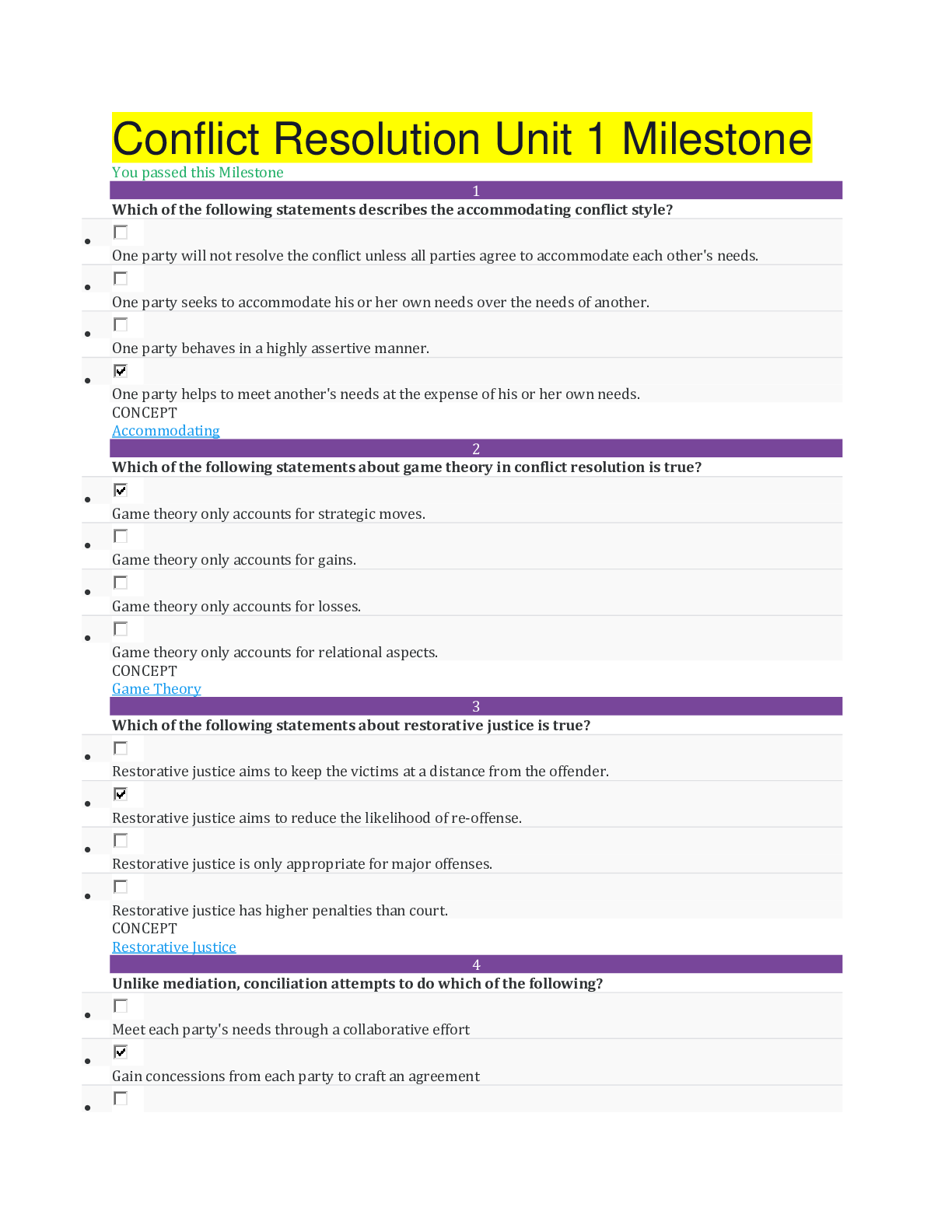
.png)
